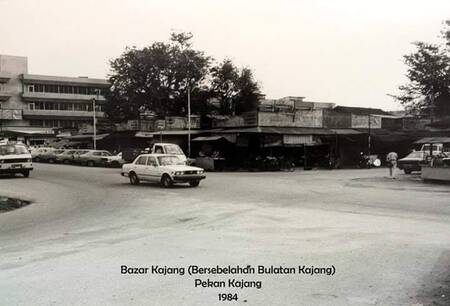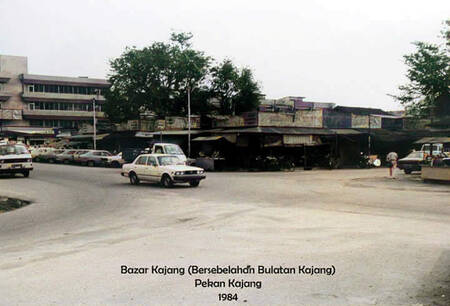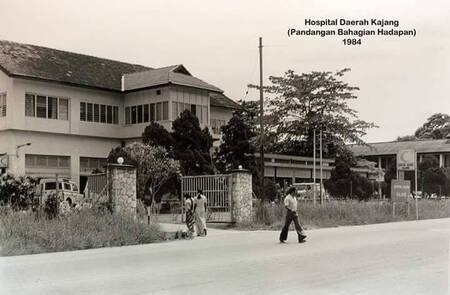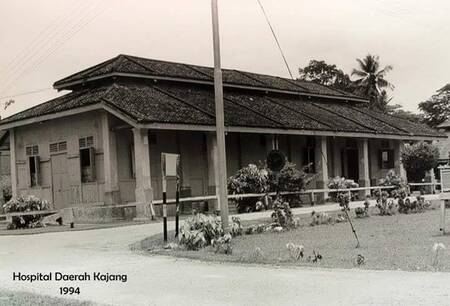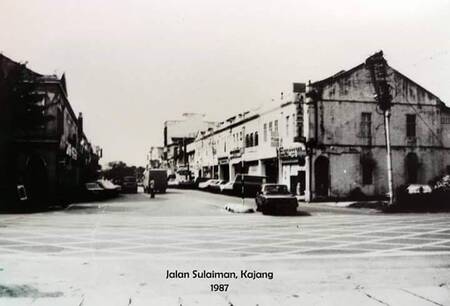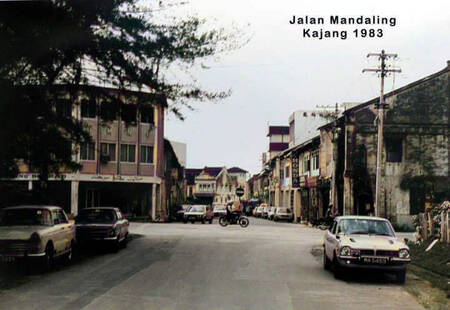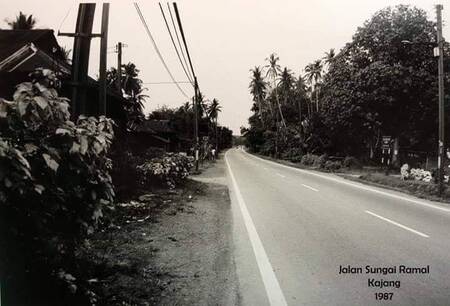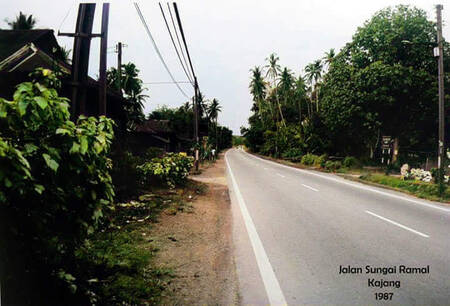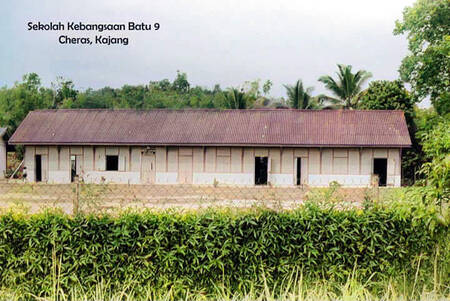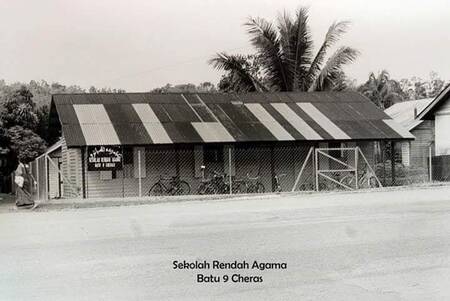Jadual Kandungan
Kajang 1980-1990-an
Dirujuk oleh
Perihal
Pada tahun 1980-an dan 1990-an, bandar Kajang masih menjadi tumpuan penduduk Bandar Baru Bangi, kerana pusat-pusat pentadbiran, perkhidmatan awam, membeli-belah, dan sebagainya, masih terletak di sini.
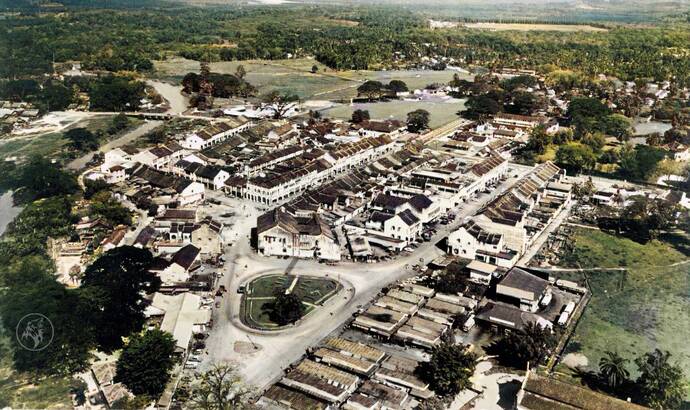
Gambar hiasan: Bandar Kajang sekitar tahun 1960-an (diwarnakan): Vijaya Kumar Ganapathy @ Facebook, 12 Julai 2021: |"An Air View' of a part of Kajang Town in the 1960's").
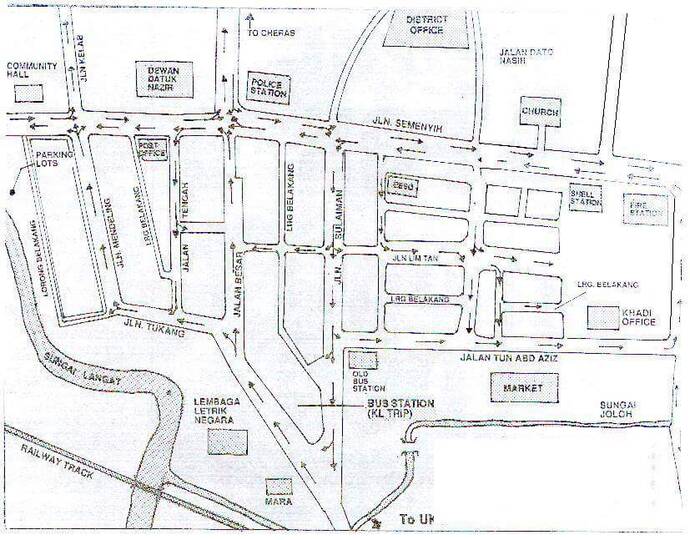
Peta lama Kajang: “This is an old map of Kajang. Development in Kajang town and its suburds is moving at a pace too fast. Its urban landscape is changing and the natural surrounding transforms. Township modernization starting from late 80s has disturbed the easy-going lifestyle of this southern town of Selangor.” (Kajang Heritage Centre乌鲁冷岳社区文物馆, 2 Ogos 2015: "This is an old map of Kajang").
Mercu Tanda
Bulatan Kajang
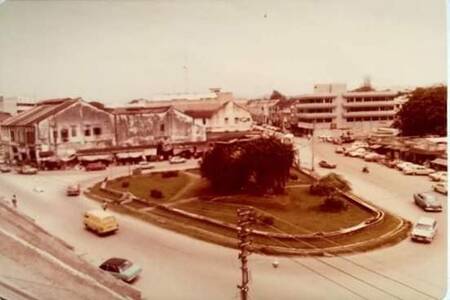

“They used to have Magic shows inside the round about on week ends … Bazaar once the best food in town” - Augustus Walter CN Jacobs. “tepi2 jln tu semua nyer bazaar…ada pawagam National dan the sun.” - Acik Leeyaa Shifah. (Facebook Bandar Kajang, 28 Oktober 2019: |"KAJANG": Bazar Kajang Pekan Kajang).
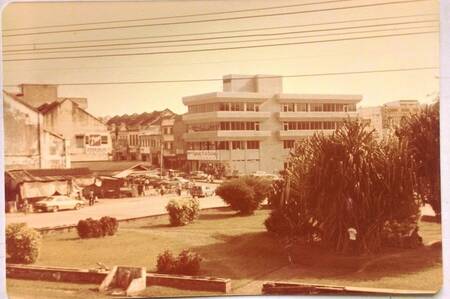
“Memori pekan Kajang, triangle about. Anda pasti melalui kawasan bila berada di pekan Kajang, tahun 1981. Foto filem Mustafa Yahya pelukis hulu langat.” (Tapa Seni Rimba @ Facebook Bandar Kajang Group, 15 Julai 2017: |"Memori pekan Kajang, triangle about").
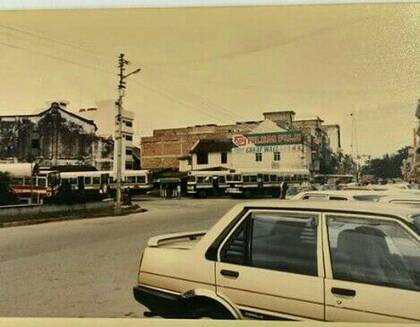

Kiri: “Lokasi pekan Kajang tahun awal 1990an” (Tapa Seni Rimba @ Facebook Bandar Kajang Group, 7 Januari 2019: "Lokasi pekan Kajang tahun awal 1990an". “Lokasi kenangan pekan Kajang tahun 1996, bulatan segi tiga , bas Foh Hup, ais ABC, mee hailam dan sate kajang. Kredit : Mustafa Yahya, pelukis hulu langat.” (Facebook Bandar Kajang, 13 Mei 2017: "Lokasi kenangan pekan Kajang tahun 1996").
Kanan: “Dulu roundabout tahun 1988 tukar as tempat tunggu bas” - Ina Abd Rahman
Panggung
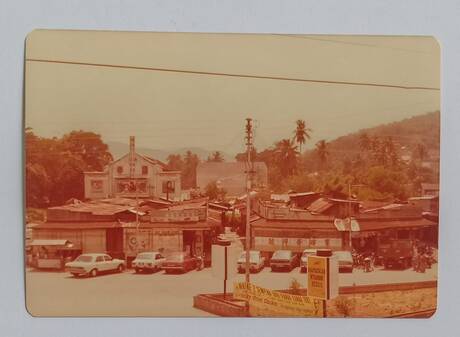

Kiri: “Panggung National dan bazaar Kajang. Dua panggung wayang dipekan Kajang pada masa saya belajar diKajang tahun 1967- 70 , panggung wayang National dan panggung wayang Sun .” (Tapa Seni Rimba @ Facebook Bandar Kajang Group, 29 Oktober 2019: |"Panggung National dan bazaar Kajang").
Kanan: “Foto Kajang pada tahun sekitar 1980an, tiada pembangunan pesat di masa itu, tinggallah satu kenangan pekan Kajang. Sekarang perubahan pesat bandar Kajang dan pembangunan moden merata, cuma saya masih melihat bandar masih belum berseri lagi, masih melihat suasana lama tanpa ada tarikan baru, seperti landmark bandar Kajang yang menarik perhatian masyarakat, wujudkan river of life sungai langat, meriahkan kawasan sate kajang, aktifkan program komuniti khasnya seni lukis, musik dan aktibiti perpaduan berbilang kaum. Kita akan bantu menyemarakkan program masyarakat dalam memupuk semangat perpaduan bangsa.” (Tapa Seni Rimba @ Facebook Bandar Kajang Group, 30 Oktober 2018: "Foto Kajang pada tahun sekitar 1980an").
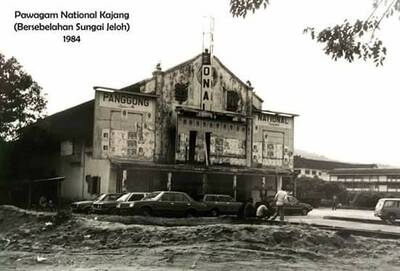
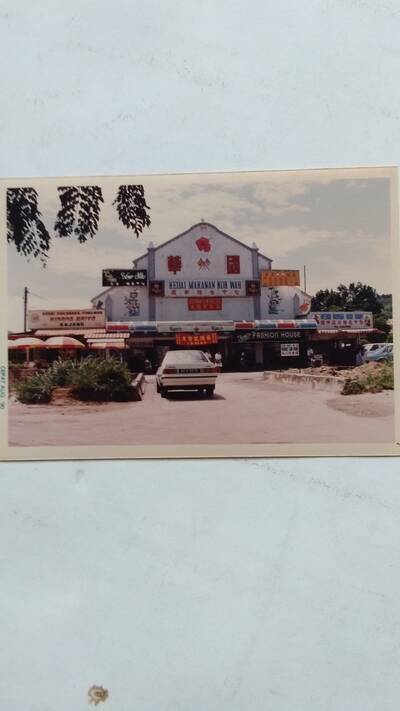
“Panggung National Kajang” (Kiri: 1984, Kanan: 1990) (Tapa Seni Rimba @ Facebook Bandar Kajang Group, 10 November 2018: "Panggung National Kajang").
“In Kajang in the 1960s, Kok Wah National Theatre was the core around which the town revolved. Very often, families would take the kids out for a matinee show on a Sunday afternoon…” (Rueann Dass, Apr 28, 2016: |"Back In Time: A 1960s Malaysian Coffeeshop").


Nama asalnya ialah “Queen Cinema”:-
“Queen Cinema or later changed to National Cinema in Kajang was established by Kong Family. Besides entertaining Kajang folks with film shows, it was also used as hall for ceremony. The pictures showed line ups of notables congratulating Ng Bow Thai being awarded title by the King.”
“Nostalgic memories of watching many movies in National Theatre. Upstairs 1.40; downstairs 1.00 and the first 3 rows .65sen. School days cheap matinee at 9.00am & 11.00 am only 40sen. On Saturdays & Sundays” - Sathyaseelan Tharmalingam
(Sumber: Kajang Heritage Centre乌鲁冷岳社区文物馆, 16 September 2015: |"Queen Cinema or later changed to National Cinema").
Bazaar
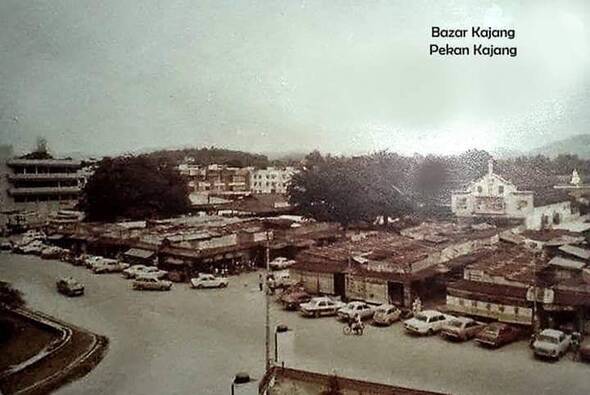

Kiri: Bazaar Kajang di hadapan Pawagam National Kok Wah, sebelah timur bulatan. Kini Plaza Metro.
Kanan: Sebelumnya, kawasan lombong bijih timah: “A closeup of 1896 map of Kajang Town. British Colonial Government then did some segmentation of the town from section 1- section 9. Early development concentrated in Section 1-4 along Jalan Mendeling, Jalan Tukang, and later extended to Jalan Besar(Main Street) and Jalan Tengah(Middle Street). The present Metro Plaza site was a tin mine by Towkay Chow Yoke who owned the row of shop houses along Main Street. If you notice a bridge over Langat River, it was not at present site. The wooden bridge link from Lorong Mendeling to the opposite bank at about 50m down the river from the present location. This is something interesting we found from National Archive. Credit to our research assistant Kah Hoe Lee who had been flipping through files and documents for months.” (Kajang Heritage Centre乌鲁冷岳社区文物馆, 16 November 2019: "A closeup of 1896 map of Kajang Town").
“KAJANG. Kajang di suatu ketika dahulu. Kini Pekan Kajang telah pesat membangun dan membawa pelbagai perubahan. Namun yang pasti memori di sini akan kekal abadi.” (Facebook Bandar Kajang, 28 Oktober 2019: |"KAJANG". Gambar warna (“colorized”) oleh Mohamad Fareez).
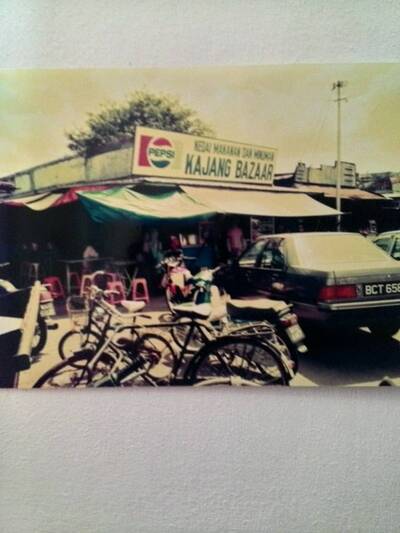

Kiri: “Lokasi nostalgia bagi saya semasa belajar di Kajang, bazar Kajang adalah tempat membeli barang2 sekolah, kedai abc, cendol dan mee yang sedap, selalu singgah selepas balik sekolah, sekitar tahun 1967 hingga 1971.Tapa.” (Tapa Seni Rimba, 14 Jun 2016: |"bazar Kajang").
Kanan: “Kedai gunting dalam bazaar tahun 1980an. … Kedai Gunting Maniam - Thevagar Gurunathan” (Tapa Seni Rimba @ Facebook Bandar Kajang Group, 17 Januari 2018: |"Kedai gunting dalam bazaar tahun 1980an").
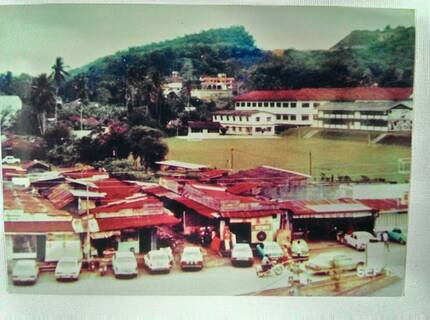

Kiri: “Sekolah convent kajang, foto tahun 1982, Sebahagian pekan kajang masih ada bazaar lama . Mustafa Yahya pelukis hulu langat.” (Tapa Seni Rimba @ Facebook Bandar Kajang Group, 3 Mei 2017: |"Sekolah convent kajang, foto tahun 1982").
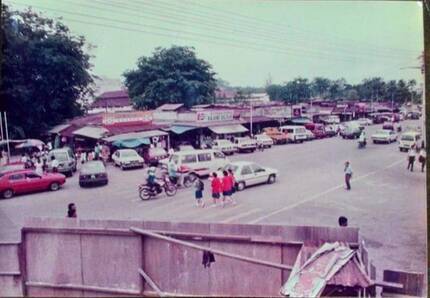

“Lokasi bazaar di Pekan Kajang tahun 1990-an. Di kiri sekali gerai yang selalu kita kunjungi, gerai ABC, cendol, mee goreng dan dibahagian depan sekali papan plywood adalah dinding pembinaan bangunan sate diselekoh depan Metro Plaza. kredit : Tapa Seni Rimba” (Facebook Bandar Kajang, 13 Disember 2020: | "Lokasi bazaar di Pekan Kajang tahun 1990-an").
“Kajang Bazaar was demolished in 1993…” (Rueann Dass, Apr 28, 2016: |"Back In Time: A 1960s Malaysian Coffeeshop").
Kelab Rotary
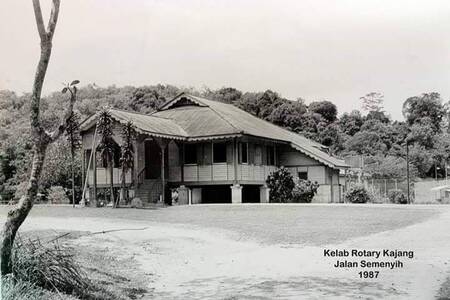

“Sold to metro” - Augustus Walter CN Jacobs (Facebook Bandar Kajang, 28 Oktober 2019: |"KAJANG": Kelab Rotary Kajang, Jalan Semenyih, 1987. Gambar warna (“colorized”) oleh Mohamad Fareez).
Bangunan Persatuan Hokkien

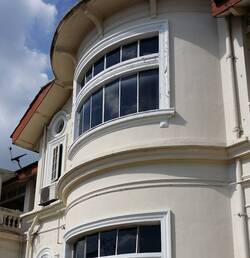

Asalnya rumah kediaman Low Ti Kok: “Low Ti Kok was one of the notable community leaders in Kajang. He established Yu Hua School and contributed to Kajang High School development. In late 1930s till his last breath during WWII, he led the Kajang Anti-Japanese Committee. A road in front of Yu Hua School was named after him as an honour. His mansion at Jalan Timur is an architectural pearl in Kajang.” (Kajang Heritage Centre乌鲁冷岳社区文物馆, 26 Julai 2016: |"Low Ti Kok's mansion at Jalan Timur is an architectural pearl in Kajang."
“The Low Ti Kok Mansion is located in the north of Kajang Town in Hulu Langat District. Historically, this mansion was built in 1932 and was owned by Towkay Low Ti Kok (1877-1943). This mansion was sold to the Hulu Langat Hokkien Association (HLHA) in 1985 and is known as HLHA building today. Today, it still stands as an old Chinese mansion that escaped the bombing during World War II in Kajang.” (Kai Zhen Chong, Azizi Bahauddin @ PLANNING MALAYSIA JOURNAL : VOLUME 15, ISSUE 1, 2017: |"FENG SHUI: THE SHAPE OF FIVE ELEMENTS OF LOW TI KOK MANSION").
Sebelumnya (sebahagian?) tapak kediaman ini beralamat di No. 3, Jalan Timur, pernah dimiliki oleh H.R. Moullin.
LATAR PERISTIWA: Hilary Rougier (H.R.) Moullin (1875-1922)
Perkhidmatan Awam
Pejabat Pos
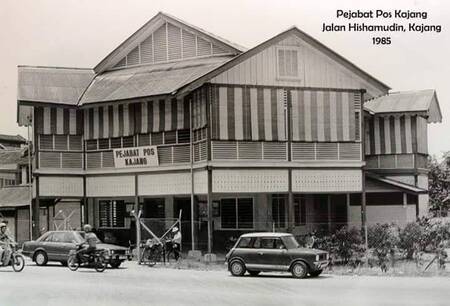

Gambar 1985: “Masih wujud” - Hilmi Roslee (Facebook Bandar Kajang, 28 Oktober 2019: |"KAJANG": Pejabat Pos Kajang, 1985. Gambar warna (“colorized”) oleh Mohamad Fareez).
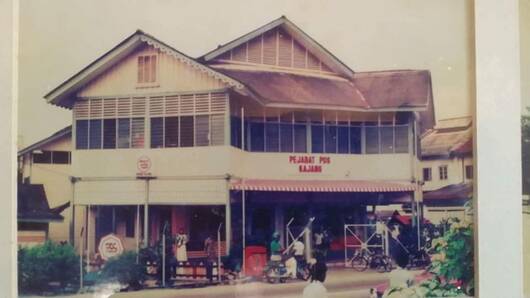

Kanan: “Paintings on urban or rural landscape may retain the original picture of buildings & structures. This watercolour picture of Kajang Post Office reveals its original facade which exhibits the blending beauty of local traditional architecture and a little from the West. Today, the ugly signboards, polycarbonate extentions…spoil the authenticity.” (Kajang Heritage Centre乌鲁冷岳社区文物馆, 3 Ogos 2015: "This watercolour picture of Kajang Post Office reveals its original facade").
Gambar kini (bahagian hadapan):-


Kiri: “Pejabat Pos lama bandar Kajang berusia 105 tahun (dibina pada 1914)” (Kurniawati Kamarudin @ Media Permata, 26 Disember 2019: |"Tarikan sejarah bandar Kajang").
Kanan: “Pejabat pos lama bandar Kajang yang masih digunakan hingga kini. - Foto Zulfadhli Zulkifli” (Rozdan Mazalan, September 29, 2019: |"Kajang kaya warisan sejarah").
Gambar kini (bahagian belakang):-


Kiri: “Located on Jalan Tengah, the building was built before WWII, and started operations in 1914. It was made with cengal and meranti wood, and has undergone renovation over the years. The design is a mix of traditional Malay classic and colonial European style. The building is a post office till today.” (Hanna Hussein @ New Straits Times, December 19, 2019: |"#JOM! GO: More than satay").
Kanan: “The rear of the post office in Kajang still keeps its old design.” (Yip Yoke Teng @ The Star, 28 Jan 2019: |"Modern look is a defaced facade").
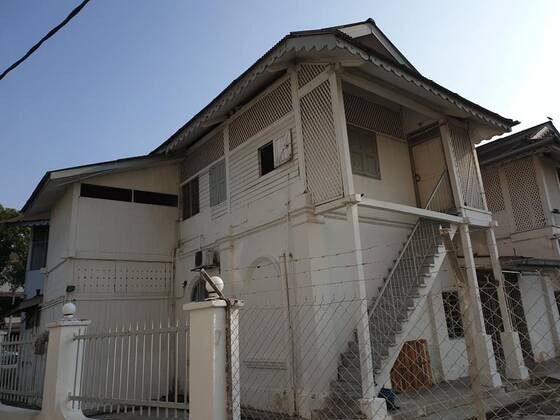

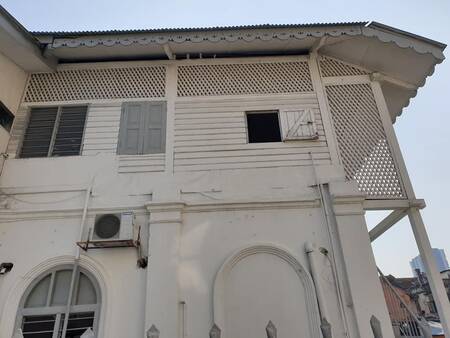

“Kajang Post Office is the only building with adaptive Tudor domestic style in town. The upper floor is timber based Malay vernacular traditional design with wooden louvre & large windows. The two stairs at rear side add to its beauty. Lower floor has relatively large pillars and arched windows built with bricks. As told by the senior officer, it was built in c.1910s, the shaping years of Kajang township. This architectural jewel has now been included as one of the seven heritage sites in the Kajang Heritage Walk. An aerial photo of Kajang taken in 1968 shows the then District Office of the similar architectural style across the road.” (Kajang Heritage Centre乌鲁冷岳社区文物馆, 19 September 2019: "Kajang Post Office is the only building with adaptive Tudor domestic style in town").
Hospital
(Facebook Bandar Kajang, 28 Oktober 2019: |"KAJANG". Gambar warna (“colorized”) oleh Mohamad Fareez).

“Kredit : Tapa Seni Rimba” (Facebook Bandar Kajang, 8 April 2019: |"Nostalgia Bandar Kajang").
Balai Bomba


“sold the prime land to metro present hotel” - Augustus Walter CN Jacobs. “virtually all prime land in Kajang has been handed over to MKH GROUP.” - Nantha Kumar Appadurai (Facebook Bandar Kajang, 28 Oktober 2019: |"KAJANG": Balai Bomba Kajang, 1976. Gambar warna (“colorized”) oleh Mohamad Fareez).

“Kenangan balai bomba Kajang sebelum lokasi berpindah ke bukit mewah Kajang.” (Tapa Seni Rimba @ Facebook Bandar Kajang Group, 18 Februari 2019: "Kenangan balai bomba Kajang sebelum lokasi berpindah ke bukit mewah Kajang."). “Lokasi jalan bukit Kajang tahun sekitar 1981, Balai bomba Kajang, Anda dan keluarga ada kenangan disini . Mustafa Yahya pelukis hulu langat.” (Tapa Seni Rimba @ Facebook Bandar Kajang Group, 16 Ogos 2017: |"Balai bomba Kajang").
Balai Polis
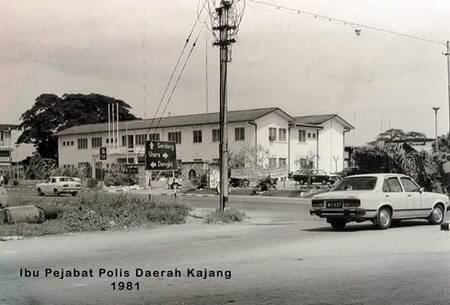

“View drpd klinik dr borhan ni” - Ns Riza (Facebook Bandar Kajang, 28 Oktober 2019: |"KAJANG": Ibu Pejabat Polis Daerah Kajang, 1981. Gambar warna (“colorized”) oleh Mohamad Fareez).


(Facebook Bandar Kajang, 28 Oktober 2019: |"KAJANG": Gambar warna (“colorized”) oleh Mohamad Fareez).
Pejabat Daerah
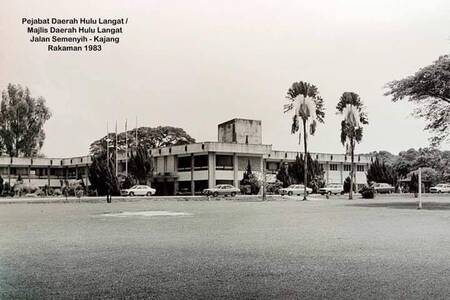

“Sold to metro.” - Augustus Walter CN Jacobs. “dulunya pejabat daerah dan majlis perbandaran adalah jabatan yg diketuai oleh org yg sama..zaman berlalu dan akhirnya berpecah kpd 2 organisasi” - Ahmad Zul S. (Facebook Bandar Kajang, 28 Oktober 2019: |"KAJANG": Pejabat Daerah Hulu Langat / Majlis Daerah Hulu Langat, Jalan Semenyih-Kajang. Rakaman 1983. Gambar warna (“colorized”) oleh Mohamad Fareez).
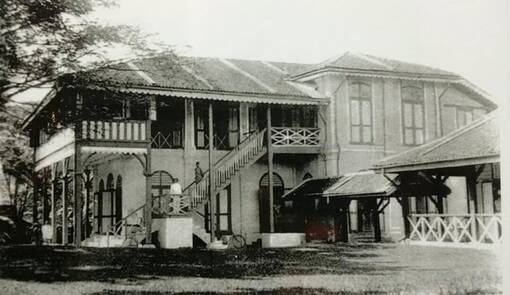

Kiri: Bangunan pejabat daerah Ulu Langat yang lama, dari jarak dekat. Ia terletak di tapak Bangunan Dato' Nazir kini (dibina tahun 1970) (Eric Lim, 2020: |History of Kajang).
Kanan: Pejabat daerah, dari jarak jauh, di sebelah kanan pejabat pos: “The aerial photo captured in 1960s showed the old District Office to its (post office's) right across Jln Hishamuddin. / An aerial photo of Kajang taken in 1968 shows the then District Office of the similar architectural style across the road.” (Lee Kim Sin)“ (Kajang Heritage Centre乌鲁冷岳社区文物馆, 17 Januari 2015: "The aerial photo captured in 1960s").
Lembaga Letrik Negara
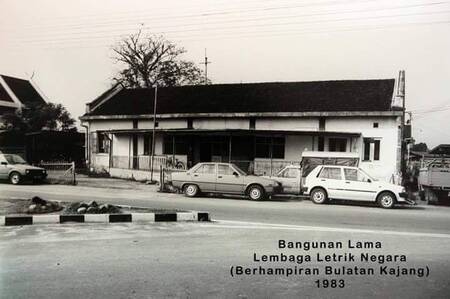

(Facebook Bandar Kajang, 28 Oktober 2019: |"KAJANG". Gambar warna (”colorized“) oleh Mohamad Fareez).
Perpustakaan
“The district office building was built in the 1910s and was in operations until it was demolished and a new building (Bangunan Dato Nazir) constructed in 1970.” (Eric Lim @ Museum Volunteers, JMM, July 15, 2020: |"History of Kajang").


Kiri: 1984: “It was called Bangunan Dato Nazir” - Kamarul Azlan. “Now is Hj Shamsuri satay kjg” - Ranishree Muniandy. (Facebook Bandar Kajang, 28 Oktober 2019: |"KAJANG": Perpustakaan Cawangan Hulu Langat, Perbadanan Perpustakaan Awam Selangor, 1984).
Kanan: Kini: “Restoran Sate Kajang Hj Samuri, terletak bersebelahan Stadium Kajang dan berhadapan stesen MRT Stadium.” (MStar, 21 Disember 2019: |"Kajang bukan sekadar ada sate sedap, tapi punyai sejarah menarik untuk dijelajah").

Bahagian dalamnya: Foto Zulfadhli Zulkifli” (Rozdan Mazalan, September 29, 2019: |"Kajang kaya warisan sejarah"). “Another iconic building is Bangunan Dato Nazir, the Hulu Langat district office from 1890 to 1970. Today, it is where you can enjoy Sate Haji Samuri for lunch and dinner! The walk takes more than two hours and covers Masjid Jamek, Stadium Kajang as well as Kajang Satay Gallery, possibly the first such gallery the world. The mini-complex gallery, which opened in 2009, is located next to Medan Sate Kajang and houses artifacts, information panels, audio visual guides and dioramas tracing the history of satay in Kajang back to 1917.” (Hanna Hussein @ The New Straits Times, December 19, 2019: |"#JOM! GO: More than satay").
Kelab Sukan / Stesen RTM


Gambar 1987: “Destroyed” - Augustus Walter CN Jacobs (Facebook Bandar Kajang, 28 Oktober 2019: |"KAJANG": Kelab Sukan Kajang, Jalan Kelab, 1987. Gambar warna (“colorized”) oleh Mohamad Fareez).
Kemungkinan bangunan yang sama setelah ditambah dan diubahsuai (2017), sebelum dirobohkan:-

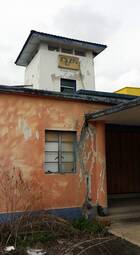
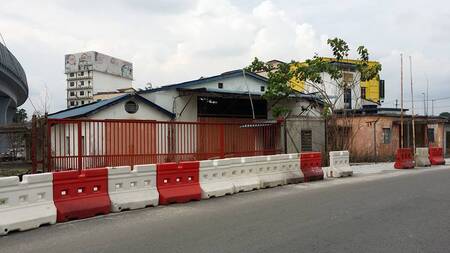


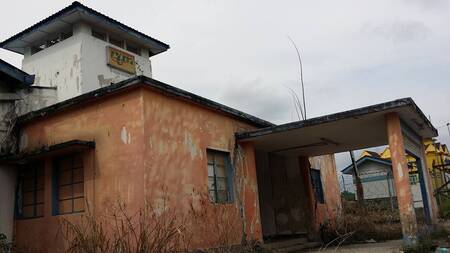
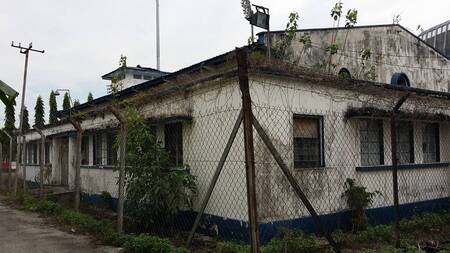

“I got a hint from a friend confirming the old Colonial architecture at the end of stadium should be the Kajang Recreation Club established in 1895. It was used as RTM store for the past decades. In the Selangor Journal published in 1890s, the British planters and Colonial officials set up the Club and hence the road leading from town to the open field and the Club was named Club Road (Jalan Kelab now). This historical building should be preserved and restored. Isn't it good if the building were to be restored and be converted into public place such as gallery or heritage centre.” (Lee Kim Sin, 11 April 2017: |"Kajang Recreation Club established in 1895").
Stadium
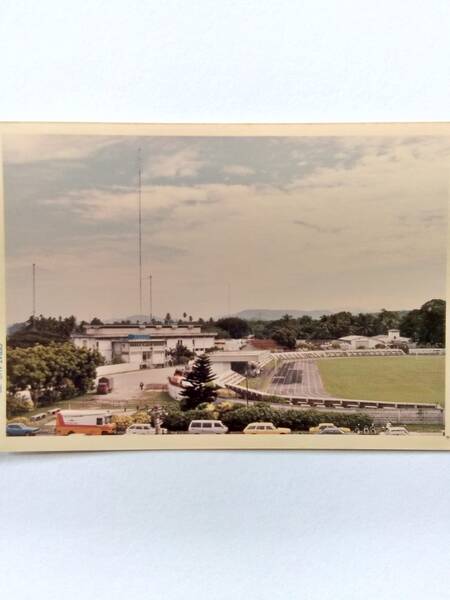

“Stesen Radio Malaysia di Kajang dan sebelahnya Stadium Kajang , foto tahun 1990 .” (Tapa Seni Rimba @ Facebook Bandar Kajang Group, 25 Mac 2019: "Stesen Radio Malaysia di Kajang dan sebelahnya Stadium Kajang , foto tahun 1990 .").
Pengangkutan Awam
Stesen Keretapi

“Lukisan stesyen keretapi Kajang jalan Reko. Saya lukis pada tahun 2012, dakwat atas kertas. Mustafa Yahya pelukis hulu langat.” (Tapa Seni Rimba @ Facebook Bandar Kajang Group, 4 Oktober 2017: |"Lukisan stesyen keretapi Kajang jalan Reko").
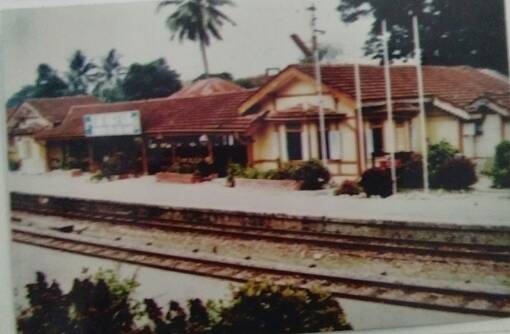

“Stesyen keretapi Kajang. Tahun 1988. Mustafa Yahya pelukis hulu langat.” (Tapa Seni Rimba @ Facebook Bandar Kajang Group, 23 Julai 2017: |"Stesyen keretapi Kajang. Tahun 1988").


“Stesyen keretapi Kajang. Foto tahun 1999. Mustafa Yahya pelukis hulu langat.” (Tapa Seni Rimba @ Facebook Bandar Kajang Group, 10 Oktober 2017: "Stesyen keretapi Kajang. Foto tahun 1999").
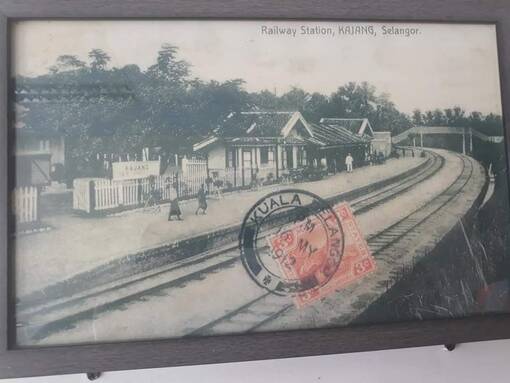

Kiri: “Kajang was linked to Kuala Lumpur in 1896 through railway line built to extend from KL to Seremban. Local historian, Azlan Sharif sent the postcard photo of Kajang Railway Station dated 1912. The curve of railway line seen in the far right, the location then was at present KTM quarters opposite Convent School.” (Kajang Heritage Centre乌鲁冷岳社区文物馆, 16 April 2020: "Kajang was linked to Kuala Lumpur in 1896 through railway line built to extend from KL to Seremban").
Kanan: “Platform view of Kajang railway station in the 1960s. The Kajang railway station used to be in front of Convent School and was accessible from Jalan Reko” (Tanarata International Schools, 2013: Kajang and Its Surrounds, m.s.14).
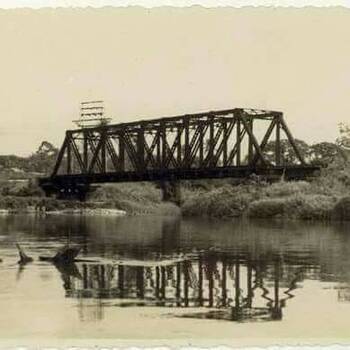

Kiri: Jambatan keretapi menyeberangi Sungai Langat, di belakang Arked Mara: “Picture of the old iron railway bridge over the Langat river. … Its location is just behind the Aked Mara building and TNB Kajang along Jalan Reko. This iron-and-wooden bridge has now been replaced with a concrete structure.” (Tanarata International Schools, 2013: Kajang and Its Surrounds, m.s.6).
Kanan: Ketika Banjir Besar Kajang 1971 (Y.K.Low, Morgan Soo, 29 April, 2008: |"The Great Kajang Flood 70's"). “The bailey bridge was replaced by reinforced concrete arches over Langat River during construction of second line. Mustaffa Yahaya, or local artist presented the more recent 1980s photo of the station. 1971 flood which was a nationwide disaster then inundated Kajang and the railroad was badly damaged.” (Kajang Heritage Centre乌鲁冷岳社区文物馆, 16 April 2020: "Kajang was linked to Kuala Lumpur in 1896 through railway line built to extend from KL to Seremban").
LATAR PERISTIWA: Banjir Besar Kajang 1971.
Bas Foh Hup
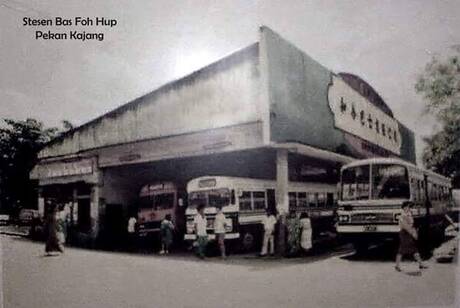

“Ini lokasi popular dipekan Kajang semasa saya belajar di Kajang dari tahun 1967 _1970 .” (Tapa Seni Rimba @ Facebook Bandar Kajang Group, 29 Oktober 2019: |"Ini lokasi popular dipekan Kajang semasa saya belajar di Kajang dari tahun 1967 _1970 .").
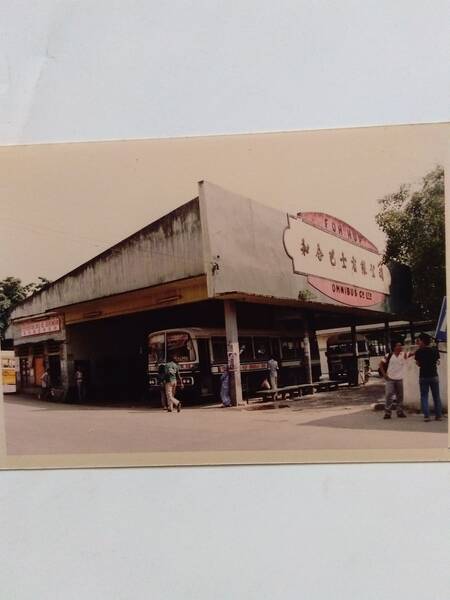

“Stesyan bas Fuh Hup Kajang, Memori saya semasa balik dari sekolah menengah jalan bukit tahun 1968-1969.” (Tapa Seni Rimba @ Facebook Bandar Kajang Group, 19 November 2017: |"Stesyan bas Fuh Hup Kajang").
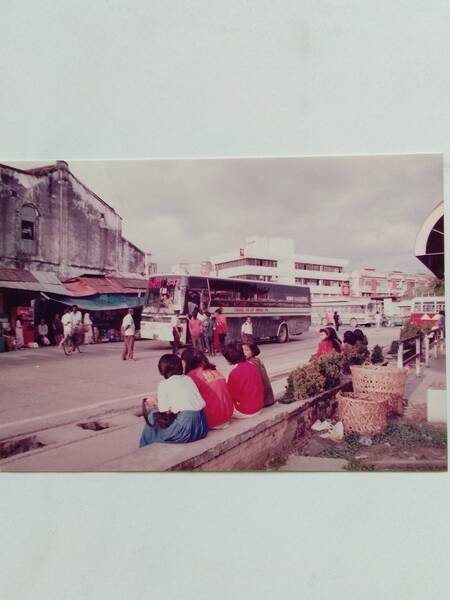

Kiri: “Suatu masa dahulu di Bandar Kajang. Kredit : Tapa Seni Rimba” (Facebook Bandar Kajang, 28 November 2020: |"Suatu masa dahulu di Bandar Kajang").
Kanan: “Inilah gayanya berebut naik bas FohHup diKajang sekitar tahun1992,anda kenal sesiapa semasa itu yang mahu menaiki bas. Kiriman : Tapa Seni Rimba” (Facebook Bandar Kajang, 22 Januari 2017: "bas FohHup").
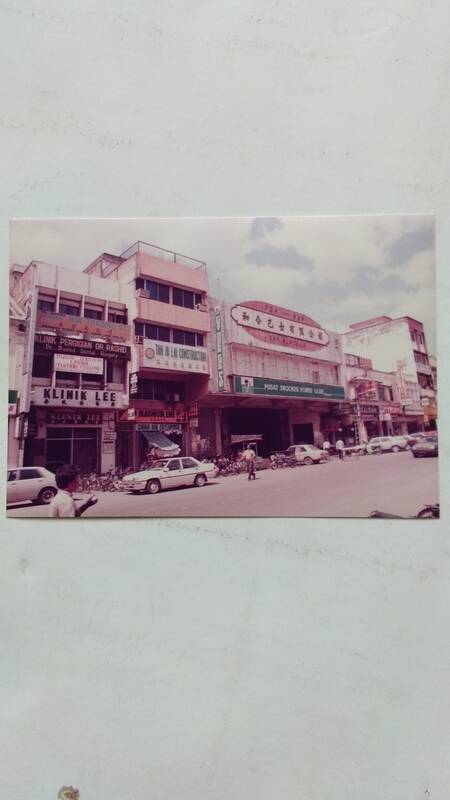

“Bus depot at Jalan Sulaiman. 芙蓉街总站。Photo courtesy: Mustaffa Yahya.”

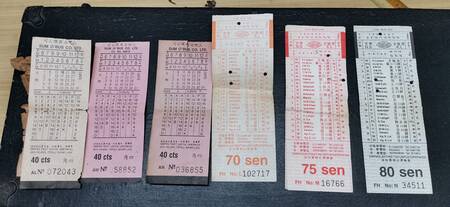

Kiri: “Bus Tickets gifted by Yee SK.余思强捐赠巴士车票。”
Tengah: Tiket-tiket bas Sum dan Foh Hup, sumbangan Tommy Chin.
Kanan: Facebook Pekan Bangi, 17 Ogos 2025.
“Foh Hup bus from Kajang had been servicing the residents for decades. Competition of new bus service and management problem forced its termination. Senior Kajangnites have fond memories travelling with Foh Hup. Thanks to Yee Sze Keong for the tickets and photo courtesy from artist Haji Mustaffa Yahya.”
(Sumber petikan dan gambar: Lee Kim Sin, 25 Julai 2020: |"Foh Hup bus from Kajang had been servicing the residents for decades.").
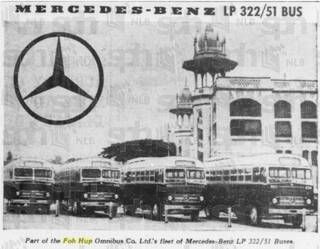
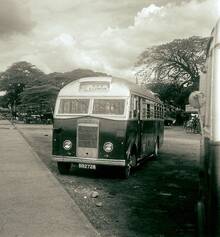
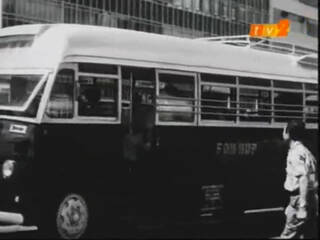
“Foh Hup Bus service was very well known with Kajang seniors. Some of them were shareholders in the cooperative concept company. Sadly, mismanagement forced the company to close down. The glory of this Kajang based bus service is part of our Kajang history.” (Kajang Heritage Centre乌鲁冷岳社区文物馆, 25 Julai 2017: "Foh Hup Bus service").
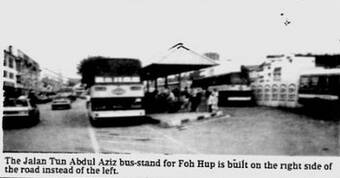
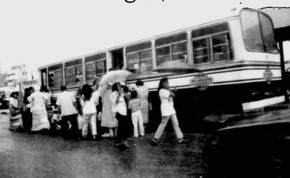
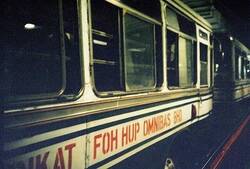
“Laporan Zaini Raban ( Utusan Malaysia, 20 April 2002) berjaya mendapatkan penjelasan mengapa syarikat Foh Hup terpaksa “Gulung Tikar”, menurut Pengarah Urusan Foh Hup Omnibus sendiri, iaitu Encik Hee Then Mu, syarikat terpaksa menghentikan operasi akibat tanggungan kerugian yang berpanjangan mulai tahun 1994. Kerapuhan prestasi kewangan menjejaskan prestasi syarikat, akhirnya mereka kekurangan bas lalu gagal bersaing dengan syarikat lain yang menawarkan perkhidmatan yang lebih baik.” (Harith Faruqi Sidek, November 21, 2012: |"Foh Hup Omnibus (1937 - 2002) : Berakhirnya sebuah legasi").
Bas Sum


“Stesyen bas Sum Kajang ,foto sekitar tahun 1986 .” (Mustafa bin Yahya (Tapa Seni Rimba) @ Facebook Bandar Kajang Group, 19 April 2019: "Stesyen bas Sum Kajang ,foto sekitar tahun 1986").

“Kelihatan dalam foto lama yang diwarnakan ini sebuah bas SUM berjenama Seddon dengan no. plate BC 48 di tahan untuk pemeriksaan keselamatan yang ketat di era Darurat. Syarikat Sum Omnibus Company telah didaftarkan sebelum tercetus Perang Dunia ke 2 lagi iaitu pada 21 April 1938 dan menamatkan operasinya pada Disember 2005 setelah 67 tahun memberikan jasa dan perkhidmatannya kepada penduduk daerah kita. Catatan ajaizainal Sept.2025” (Faizal Zainal @ Facebook Pekan Bangi, 3 September 2025: "Catatan Sejarah Daerah Kita. Bas SUM Dibakar Komunis").
Hentian Teksi
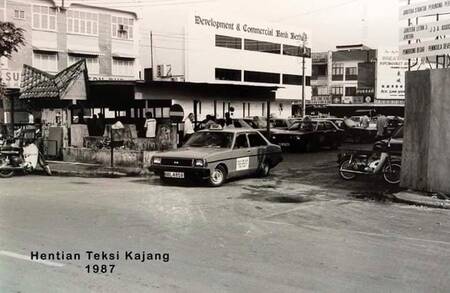

“Development and commercial bank is now RHB bank” - Shanker Nanthini. (Facebook Bandar Kajang, 28 Oktober 2019: |"KAJANG": Hentian Teksi Kajang, 1987. Gambar warna (“colorized”) oleh Mohamad Fareez).

“Satu masa dulu pasar sabtu dikawasan jalan simpang stesyen teksi sekarang hingga bank BSN Kajang. Kredit : Tapa Seni Rimba” (Facebook Bandar Kajang, 11 April 2017: "pasar sabtu").
Sekolah
Sekolah Hua Qiao
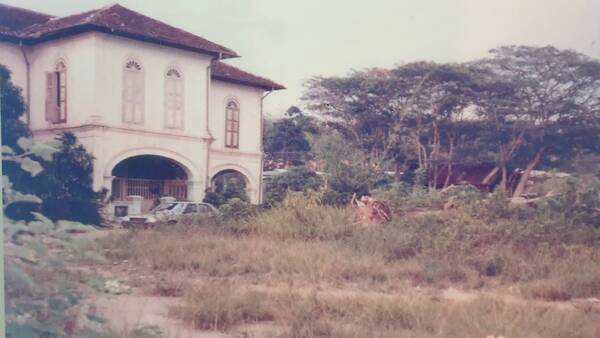
“A very early Anglo Malay mansion in Kajang. Was once the Overseas Chinese High School. Demolished to make way for New Era University College.” (Caleb Goh @ Facebook, 14 Ogos 2023: |"A very early Anglo Malay mansion in Kajang").
Maklumat lanjut: Sekolah Hua Qiao / Wah Chiau / Hwa Chiau / Fah Khiuw (华侨学校) (1912).
SRJK Cina Yu Hua
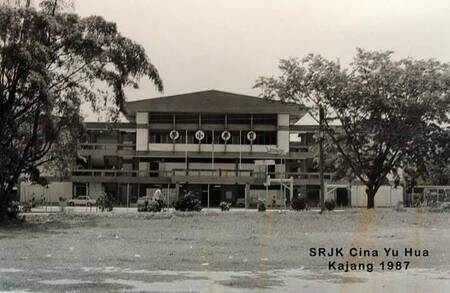

“Sold to metro” - Augustus Walter CN Jacobs. (Facebook Bandar Kajang, 28 Oktober 2019: |"KAJANG": SRJK Cina Yu Hua, 1987. Gambar warna (“colorized”) oleh Mohamad Fareez).
Kajang High School


“block utama .. Bukan asrama” (Facebook Bandar Kajang, 28 Oktober 2019: |"KAJANG": Kajang High School, 1987. Gambar warna (“colorized”) oleh Mohamad Fareez).
Maklumat lanjut: Kajang High School (KHS) (1919).
SK Jalan Semenyih 1 & 2
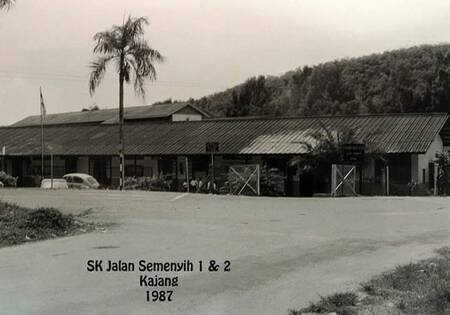

“Blkg sekolah tu skg ni wisma apex/metro/kfc.” - Hanaffi Nordin. “Bangunan tinggi blkg tu asrama tun Abdul Aziz high-school kajang.” - Mars Phyzel. “SRJK (Inggeris) 1, Jalan Semenyih, Kajang. Sekolah rendah saya dari tahun 1965 hingga 1970. Guru besar Mrs. AP Richards.” - Mazilan Jalal. (Facebook Bandar Kajang, 28 Oktober 2019: |"KAJANG": SK Jalan Semenyih 1 & 2, 1987. Gambar warna (“colorized”) oleh Mohamad Fareez).
Maklumat lanjut: Kajang High School: 1955: Pembukaan Sekolah Rendah.
SK Jalan Bukit
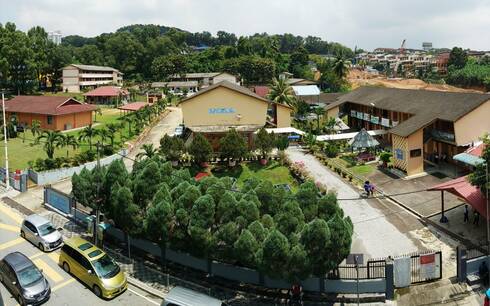
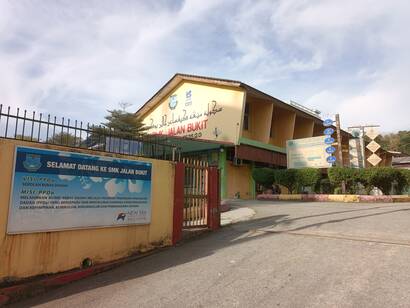
Kiri: SK Jalan Bukit (Satu), 2018 (Facebook Skjbsatu Kajang Selangor, 25 Oktober 2018: "Skjbsatu Kajang Selangor").
Kanan: SMK Jalan Bukit, *angys* @ Wikimedia, 9 Julai 2022: "SMK Jalan Bukit, Kajang").
Maklumat Lanjut: SK Jalan Bukit (1964).
Pusat Bandar
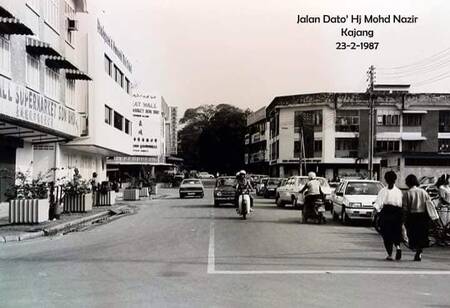

“Once a play ground field” - Augustus Walter CN Jacobs. “Great Wall Supermarket” - Adeeb Fahmi. “Bank rhb. Sekarang penuh kedai handphone je” - Faiz D. Ace. (Facebook Bandar Kajang, 28 Oktober 2019: |"KAJANG": Jalan Dato' Hj Mohd Nazir, 23-2-1987. Gambar warna (“colorized”) oleh Mohamad Fareez).
Premis dan Kedai
Kedai Terawal
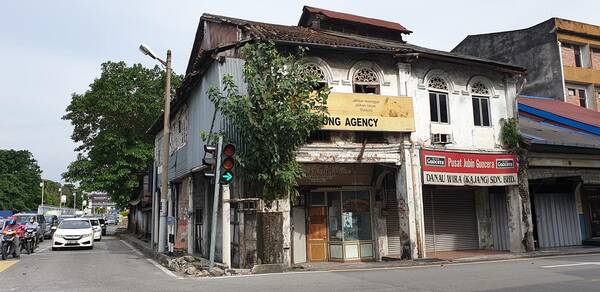

Kedai terawal dibina pada tahun 1896: No.1 Jalan Besar: “In 1896, 40 shop houses were built in Section 1 which covered Main Street, Tukang Street, Jln. Tengah and Mendaling Street. This shop house which is no.1 at Main Street and the one beside could be of earliest batch or built within the decade. This corner lot was said to be acquired and demolished to give way for road broadening. Or, should it be conserved and restored and repurposed to mark the history of establishment of Kajang Town?”
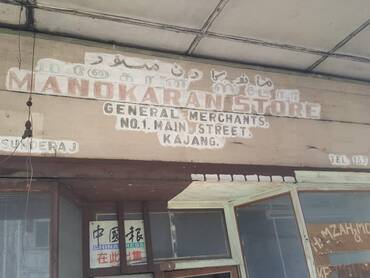
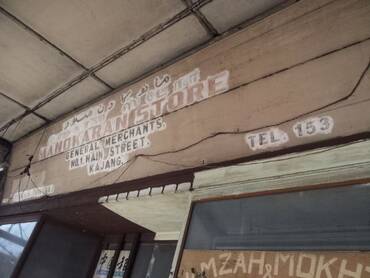

Gambar di kaki lima kedai ini. Sedikit latar belakangnya: “This is a corner lot at a busy cross section into Kajang. It is in a vary bad condition. It is also the only traditional shophouse of the early merchants with a cantilivered gallery on its long side covered with wooden louvered windows. Surpporting this gallery are cast iron columns which have come from Europe at that time. It was the most impressive building you see as you enter this tin mining and rubber town. The front facade has three traditional full height windows with carved motives on top. The ground floor must have seen many tanents doing all sorts of local trades. If the local council has the foresight and the money it ought to safeguard this unique historical and cultural landscape of old Kajang. This main street ought to be pedestrainised like many old streets in out towns and city. Keep the traffic out. Give the place back to the residents…if there are any..” - Victor Chin.
“It was newspapers agency and barber shop before closing down few years ago. … Take a close look at old board overhanging entrance of a shophouse at Main Street, Kajang. The 3-digit phone number tells decades of stories.” - Lee Kim Sin.
“before the Newpaper agency used that shop, two tenants before that was a Sri Lankan tamil gentleman who ran a Sundry Shop or a General Trading shop. His wife was a teacher in SRJK (1) Jalan Semenyih where the headmistress was Mrs A.P. Richards.” - Robert R Samuel.
“I use to stay at 2 Main St. until Form 1 and yes 1 Main Street is run by Lai family Newagency and also barber shop En.Hamzah. Behind is a petition writer.” - MinHo Kong
“Opposite it was a bread factory. Used to buy hainam bread there every night, then heading to Jln Sg Chua, to buy fish ball noodle near Sungai Langat for supper.” - Johnny Ho.
“yes, Mr. Mak the Hainanese bread man.” - Lee Kim Sin.
(Sumber: Lee Kim Sin, 19 Oktober 2020: |"Which is the oldest building in Kajang?". Gambar tengah: Lee Kim Sin, 27 Februari 2015: "The 3-digit phone number tells decades of stories").



“While walking back to Kajang Heritage Centre from Kedai Buku MakAli, took a photo of the narrow five-foot way linking old shophouses along Jalan Tengah. The row of relatively smaller shops are supposed to be the earliest brick shophouses in Kajang Town. History record says that the first batch of brick shops were built in 1895. The road was named Jalan Raja Alang in honor of a Mandailing Chief. But, it was renamed Jalan Tengah or Middle Road.”
Gambar tengah: “At the end of the road linking to Jalan Tukang is a century old shop named Kah Chong. The exposed bricks on the weathered wall seems to exhibit the history of Kajang Town.”
(Sumber: Lee Kim Sin, 26 Februari 2017: |"narrow five-foot way linking old shophouses along Jalan Tengah").
LATAR PERISTIWA: Raja Alang bin Raja Berayun.
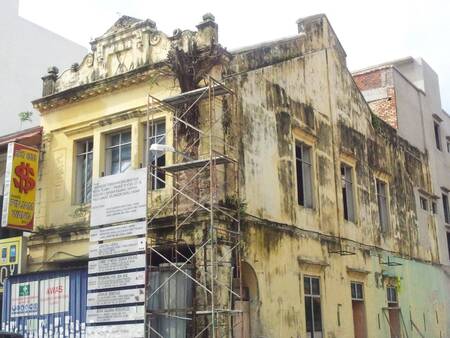

“This 1930 building in Kajang Town was owned by Low Boon Liew. In 1907, Low owned 3 shophouses in Town,was active in rubber planting & operated a brick kiln. He was the only one Chinese appointed to the five-member District Licensing Board for 1926-1927. The facade carries 2 plaster-carved flags which signify Guomindang & the Republic of China. The old buildings & walls in old Towns are embedded with stories & history.” (Lee Kim Sin, 2 Mei 2015: |"This 1930 building in Kajang Town was owned by Low Boon Liew").

(Gambar: Hanchoo, 15 Mac 2015: |"Kajang Cultural Mapping").
Kedai Emas Lee Chang Long


“Only if you were to spare some time walking slowly and looking up at the structures and designs of the old shop houses along Jalan Sulaiman, Jalan Besar, Jalan Tukang and Jalan Mendaling, you will notice artistic design and year of construction displayed at the buildings. Most of the buildings in “Kajang Old Town” were constructed around 1920s to 1930s. The architecture of these shop houses is a combination of traditional Chinese and European design. The ground floor was used for commercial activities and the upper floor as living space for the family. The older street of Jalan Tukang has more varied display of design as compared to others. Till today, the corner Lee Chang Long goldsmith shop stands as a Kajang landmark. Formerly named Hong Bee, i.e. Low Ti Kok’s shop had a panel of cast-iron floral motif (picture) which was torn down and replaced by flat wall some years ago.” (Lee Kim Sin, September 4, 2007: |"Old Buildings, Architectures and Structures in and around Kajang Town". Gambar kanan: Hanchoo, 15 Mac 2015: |"Kajang Cultural Mapping").
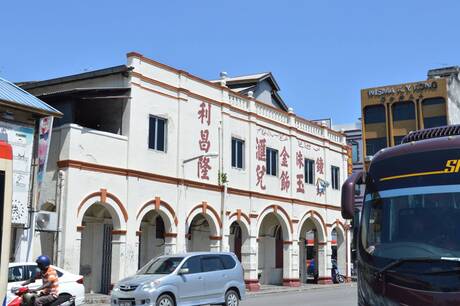

“Kajang landmark building- Lee Chang Long Goldsmith Shop ended its business after serving the community for a century. Rapid development in Kajang had brought fast changing landscape physically our its livelihood. Preservation & conservation of Kajang heritage needs immediate action from the authority or the community before it gets faded out or deminished.” (Lee Kim Sin @ Kajang 加影 Facebook, 22 November 2013: "Kajang landmark building- Lee Chang Long Goldsmith Shop". “Walaupun Kedai Emas Lee Chang Long yang beratus tahun telah tamat peniagaan, tetapi kesan Kedai Emas Lee Chang Long yang mashur tetap boleh dijumpai di bangunan lamanya. Biarpun, papan tandanya yang ditutup oleh papan tanda kedai emas yang baru masih dapat dilihati.” (Kajang Heritage Centre乌鲁冷岳社区文物馆, 3 Februari 2015: "Kedai Emas Lee Chang Long".
Gambar kanan: Mohd Nasir Abdul Rashid, April 16, 2008: |"Kajang Town".


“Lin Chen Hoh,78 tahun, bekas pekerja Kedai Emas Lee Cheong Loong. 'Saya bekerja di kedai emas Lee Cheong Loong sejak tahun 1962, belajar dari perantis, beberapa tahun kemudian dipromosi oleh bos dan mula mengambil urusan perniagaan ini. Kedai Emas Lee Cheong Loong Sdn. Bhd. ditubuhkan pada 22 April 1924, sudah sebanyak 91 tahun! Ia ditubuhkan oleh 4 orang pengasas dan mempunyai seorang diretori bertugas mengurus akaun. Pada zaman kegemilangannya , sebanyak 18 buah kedai bersekutu telah ditubuhkan di seluruh Negara!'” (Kajang Heritage Centre乌鲁冷岳社区文物馆, 31 Januari 2015: "Lin Chen Hoh,78 tahun, bekas pekerja Kedai Emas Lee Cheong Loong").
Tukang Ayan Sin Wah Cheong
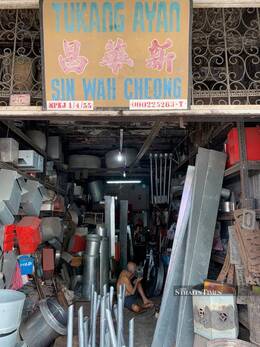

“Tukang Ayan Sin Wah Cheong, a more than 80-year-old tinsmith and metal welding shop owned by Low Woo Ngee, 81, the third generation owner. Low learnt the techniques of smithing from his father when he was just 11. In the old days, charcoal was used for welding and later this was changed to fuel oil. However, due to the rising price of oil, Low has turned to gas. In the 1960s, Kajang town had more than six metal welding shops due to high demand to make rubber-tapping and tin mining tools. Today, the business is declining and Low is struggling to keep afloat.” (Hanna Hussein @ The New Straits Times, December 19, 2019: |"#JOM! GO: More than satay").
““这个打铁的声音对加影人肯定不会陌生,因为这一个声音已经在加影的后街响了将近一个世纪。新华昌白铁店,自开业的这几十年来,见证了加影老街的无数变化~~ 《老加影之新华昌白铁店》” (TV2《前线视窗》, RTM, 6 Mei 2016: "老加影之新华昌白铁店").
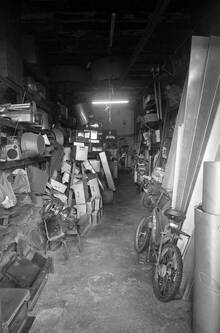
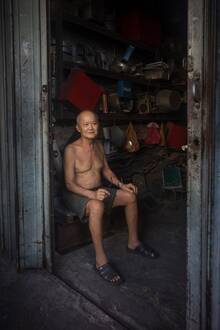

Beliau meninggal dunia pada 28 Mei 2020: “Mr. Low, our Kajang tin Smith in town has left us today. It's too sad to miss our heritage craftman who had been so friendly in receiving students and visitors to learn more about his life long engagement. His kindness, laughter and knocking sound from Sin Wah Cheong will be in our memory forever. May his soul rest in peace. ” (Gambar kiri & tengah: LIFE in A Frame (Shiha's Street Photography), 1 Mei 2016: "KAJANG, SELANGOR").
(Sumber petikan dan sebahagian gambar: Kajang Heritage Centre乌鲁冷岳社区文物馆, 28 Mei 2020: |"Mr. Low, our Kajang tin Smith in town has left us today").
Biskut Kwong Sang Woh
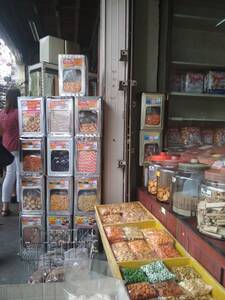
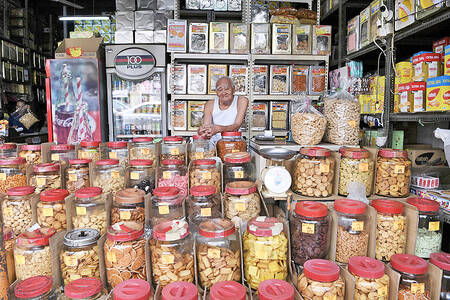

Kiri: ”…we passed by very old traditional shops like kedai biskut which offer a wide selection of cookies and sweets presented in large transparent glass jars and metal boxes with a transparent side to allow the customer to identify the type of cookie and appreciate their quality.“ (Josiane Reggane, 10 February 2020: |"Kajang Walking Tour @ 10 February 2020").
Tengah: “Peniaga, Siew Poh Chang menjual lebih 400 jenis biskut yang diimport dari Thailand dan kilang biskut seluruh negara di kedai warisan keluarganya.” (Kurniawati Kamarudin / Bernama @ Media Permata, 26 Disember 2019: |"Tarikan sejarah bandar Kajang").
Kanan: “Uncle Siew, the owner of one the oldest shops in Kajang Town. Kedai Biskut Kwong Sang Woh is owned by Siew Bak Chong. He is 88 and is the second generation of the more than 100-year-old shop! The shop, which started as a small grocery store, was owned by his father. Later, his father started to sell biscuits and Chinese prayer items. Today, the shop focuses on selling sweets and biscuits, and there are more than 400 types of biscuits including the popular colourful ice gem biscuits priced at RM13 per kilogramme. Glass jars are used to keep the biscuits fresh and crispy.” (Hanna Hussein @ The New Straits Times, December 19, 2019: |"#JOM! GO: More than satay").


“Biskut popular seperti ini masih digemari dari zaman saya dulu tahun 1970an, lokasi kedai ini sebelah maybank Kajang. Foto pagi tadi 8. 12. 2018.” (Tapa Seni Rimba @ Facebook Bandar Kajang Group, 11 Disember 2018: "Biskut popular seperti ini masih digemari dari zaman saya dulu tahun 1970an". Gambar kiri: LIFE in A Frame (Shiha's Street Photography), 12 Mei 2016: "KAJANG, SELANGOR").
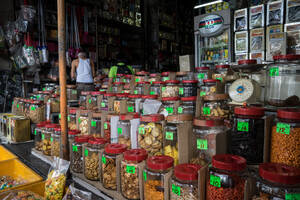
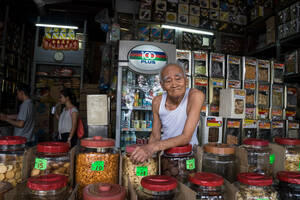
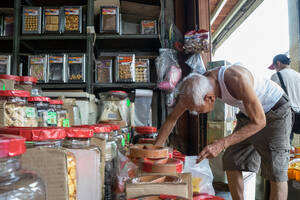
(Gambar: Hanchoo, 15 Mac 2015: |"Kajang Cultural Mapping").
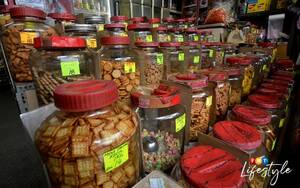
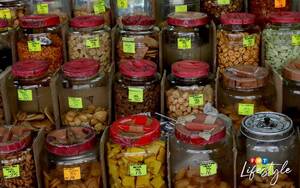
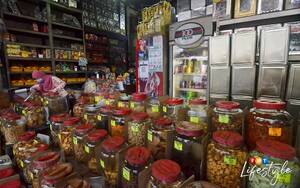
“Right in the heart of Kajang lies Xin Kwong Sang Woh Enterprise, a well-loved shop selling over 4,000 varieties of biscuits and snacks from yesteryear. You can’t possibly miss this store, one quick glance from the corridor reveals hundreds of tins, literally stacked from floor to ceiling, filled with biscuits of every taste, texture, colour and shape. Sitting behind the shop’s counter is a fragile-looking man. He’s clearly too old to be weighing biscuits and filling them into jars but his mind is still active as he quietly does the accounts and occasionally smiles at the excited customers streaming in. After all, this store has been his home since his birth. He is 90-year-old Siew Pak Chong, the second-generation owner of this historical landmark.” (Reena Sekaran @ FMT Lifestyle, August 20, 2020: |"113-year-old shop still selling 4,000 kinds of biscuits").
“More than fifty huge glass jars with red lids, and metal tins neatly arranged on metal shelves, from low to high, layer by layer, containing a wide variety of traditional biscuits and snacks, in a dazzling array of nearly a hundred flavours. Kwong Sang Woh, located in Kajang's old town, has been in business since 1907, staying in the same address for over a century, retaining the brick arcade architecture. 87-year-old Siew Pak Chong is the second generation owner, still quick-witted and alert despite his old age. He is a fixture at the shop counter, where he collects payments or chit-chat with his friends. Originally a grocery store, Kwong Sang Woh mainly sells daily supplies, and also a few biscuits. Since his son Siew Zi Kin (transliteration) and daughter-in-law Tan Bee Kien took over the reins, the shop gradually underwent a series of changes to specialize in selling traditional biscuits, their means of surviving business hardships faced by traditional grocery stores. Their customer base has also expanded outside ethnic Chinese to include other races such as Malays and Indians, and they are always busy. The golden era of grocery stores dated back in the 1950’s and 60’s, where you could find one almost everywhere, be it hustling streets or remote villages. Besides providing day-to-day goods, grocery stores also function as a uniting spot for the community to exchange information and build relationships. With the rapid economic growth and changes in the consumer market, dawns the elimination of traditional grocery stores. Chain hypermarkets, supermarkets, and mini marts spring up in residential neighbourhoods like mushrooms after the rain, dealing a heavy blow to traditional grocery stores. How would traditional grocery stores stand against pressure from the market segment, internet, monopolization, and operation difficulties, would be a topic worth exploring.” (文 Text/ 林汇川 Daniel Lim & 潘慧雯 Pua Hui Wen, © 2019 ECHINOIDEA SDN BHD: "加影的饼干店 Biscuit Shop in Kajang").
Kedai Ubat
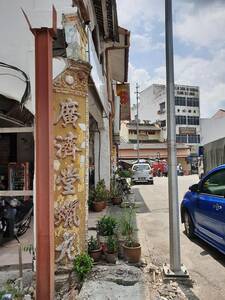

“So glad and relieving to see the old signage on pillar of the old medicine shop uncovered. This is part of the nostalgic scene in Kajang old town. Kajang Heritage Centre乌鲁冷岳社区文物馆will help restore this invaluable old signage.” (Kajang Heritage Centre乌鲁冷岳社区文物馆, 27 Mac 2019: "the old medicine shop").
Kedai Fui Onn Loong
No. 3 Jalan Besar.
Kedai kertas berhala terakhir di Kajang: “The last joss paper shop at Jalan Besar, Kajang.” (TV2《前线视窗》, 26 Ogos 2016: "Kedai Fui Onn Loong").
Satay Haji Tasmin
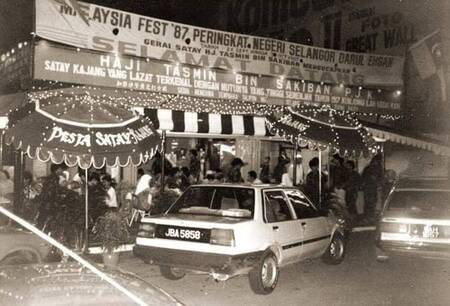

“Kena dengan ayaq tebu pure dia … Masa tu satey Kajang harga RM0.60 saja” - Eusof Mohdroslee (Facebook Bandar Kajang, 28 Oktober 2019: |"KAJANG": Satay Haji Tasmin bin Sakiban, P.J.K., 1987. Gambar warna (colorized) oleh Mohamad Fareez).
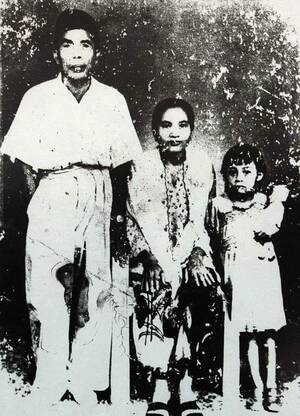

Kiri: “Haji Tasmin bin Sakiban dipercayai pengasas sate di Malaysia. Sate di Kajang dipelopori oleh Hj. Tasmin bin Sakiban pada tahun 1917. Beliau berasal dari Pulau Jawa, Indonesia. Pada tahun 1914, Hj. Tasmin tiba di Kajang melalui Sungai Langat dan beliau berlabuh di tebing Sungai Jelok (kini lokasi itu adalah belakang Plaza Metro). Wak Darmon, iaitu bapa saudara Hj. Tasmin yang mengajaknya datang ke Kajang. Adik kandung Hj. Tasmin, iaitu Rono bin Sakiban sampai ke Kajang lebih awal iaitu pada tahun 1911. Hj Tasmin memulakan perniagaannya di Kajang dengan menjual sup dan nasi kepal atau ketupat. Pada tahun 1917, Haji Tasmin memulakan perniagaan satenya. Pada ketika itu, semua pelanggan memakan sate dengan mencelup sate ke dalam satu mangkuk kuah yang besar. Sate dijual secara berkandar di sekitar kawasan Kajang bermula dari Kampung Paya, Batu 14 hingga Pekan Kajang. Penjaja sate ini akan menyinggah ke rumah-rumah yang memanggilnya di sepanjang perjalanan. Rono turut membantu Haji Tasmin untuk menjual sate secara sambilan. Beliau bekerja di ladang getah beberapa tempat seperti di West Country, Kajang. Maklum balas daripada pelanggan telah mengubah cara sajian sate. Haji Tasmin memperkenalkan mangkuk besar dan kecil untuk setiap pelanggan. Para pelanggan tidak lagi berkongsi mangkuk untuk mencelup kuah sate. Kemudiannya mangkuk kecil dan cili disediakan untuk pelanggan yang inginkan rasa kuah yang pedas. Ada pendapat mengatakan Wak Darmon juga menjalankan perniagaan sate selepas Haji Tasmin. Perniagaan sate Wak Darmon diteruskan oleh anaknya Wak Bagong dan menantu lelakinya Rono Sakiban. Pada awal 1940, sate dijual menggunakan kereta tolak dan berhenti di Kedai Kopi Ban Seng di Jalan Sulaiman sekarang. Pelanggan sate akan duduk di sekliling kereta tolak dan ada juga yang makan didalam kedai kopi. Sate di Kajang seterusnya berkembang di gerai-gerai sate, medan sate lama dan baharu serta menerima tempahan untuk jamuan di semua peringkat. Sekarang sate dihidangkan di hotel-hotel besar dan juga dalam sistem Penerbangan Malaysia (MAS). Sumber: Facebook Hj Azam Aziz” (Facebook Bandar Kajang, 10 Julai 2020: |"Haji Tasmin bin Sakiban dipercayai pengasas sate di Malaysia").
Kanan: “Foto penjaja sate 1930an, diwarnakan semula. … Menurut sasterawan Selangor Maaruf Mahmud dalam catatan autobiografinya, semasa beliau belajar di Kolej Bahasa Jepun yang terletak di Pekan Kajang pada tahun 1943, harga secucuk sate di Kajang adalah 2 sen, kemudian baru kemudiannya naik 3 sen dan 4 sen secucuk. Kalau beli 100 cucuk catatnya harganya cuma 3 ringgit sahaja, cuma perlu duduk sekitar 1 jam di bangku kayu kecil menunggu 'wak sate' siap membakarnya satenya. Kini harga sate Kajang sekitar RM1.50 - 3 secucuk, perniagaan yang bermula secara menjaja dari rumah ke rumah dan di sudut pekan kini menjadi perniagaan yang maju dan menguntungkan. Restoran Sate Kajang Hj.Samuri contohnya boleh kita anggap salah satu restoran paling besar di Kajang yang dibelinya dengan harga 12 juta pada sekitar tahun 1998. Restoran yang asalnya merupakan bekas bangunan Dato' Nazir ini terletak di hadapan stesen MRT Stadium Kajang boleh memuatkan lebih daripada seribu pelanggan dalam satu - satu masa…beza benarlah dengan zaman tahun 40an penjaja hanya ada 3 - 4 pelanggan sahaja dalam satu - satu masa yang duduk dibangku - bangku kecil. Sate Kajang yang asalnya dipelopori oleh Haji Tasmin, Rono & Wak Darmon (bapa saudara mereka) yang mula menjaja di Pekan Kajang pada tahun 1916 telah meninggalkan legasi besar aset budaya untuk daerah kita dan diraikan oleh semua bangsa yang juga telah berjaya membawa nama dan identiti Kajang terkenal dengan jolokan 'Bandar Sate Malaysia'.” (Faizal Zainal @ Facebook Pekan Bangi, 20 Ogos 2025: "Catatan Sejarah Daerah Kita. Sate Kajang Era 40an").
Kedai Kopi Mui Suan
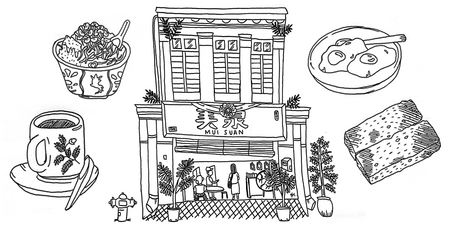

Kiri: Lukisan Kedai Kopi Mui Suan yang asal, oleh Hwans Lim.
Kanan: Kedai Kopi Mui Suan kini (dengan sebahagian hiasan asalnya), setelah berpindah ke Pasar Besar Kajang.
“In Kajang in the 1960s, Kok Wah National Theatre was the core around which the town revolved. Very often, families would take the kids out for a matinee show on a Sunday afternoon and after, there was only one place to go: Mui Suan. My grandmother, my Ah Po built a coffeeshop from her savings during the Japanese occupation. Having migrated to then Malaya from Hainan Island, she worked hard, selling ais kacang and cendol out of a wooden pushcart. No one knew why she was never given a difficult time by the Japanese, as many at the time were. Perhaps food was seen as sacred and those who peddled it were spared. Or maybe the Japanese simply enjoyed her homemade cendol too much. A few year after the occupation ended, Ah Po had saved enough money to buy two adjacent shophouses. One for Ta Leh (meaning ‘Uncle’ in Hainanese), and one for Papa. That’s how Mui Suan began in 1954, in the corner lot shophouses of Kajang Bazaar. Set between the local theatre and high traffic Foh Hup bus station, every day was a good business day at Mui Suan. Ta Leh helmed the coffee and toast station, straining coffee through stocking-like bags with water boiling over a charcoal fire. Ah Po scooped short, thick tails of freshly made cendol into a bowl of shaved ice. Papa and Mummy manned their nasi lemak stall out front, serving porcelain plates of the national breakfast to regular customers-turned-friends — my classmate’s father, the friendly Indian aunty who lives across the road, Papa’s drinking buddies. Kajang folks patronised Mui Suan profusely, and not just for their breakfast fix. … Kajang Bazaar was demolished in 1993 and Mui Suan has since moved to Pasar Besar Kajang on Jalan Jelok to a much smaller establishment. It’s a lot less glamourous than it used to be, but it still serves the oldest of friends.” (Rueann Dass, Apr 28, 2016: |"Back In Time: A 1960s Malaysian Coffeeshop").
Bengkel Chandran
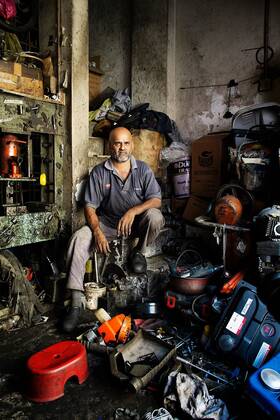

“Mr. Chandran, 44 years old - A local from Kajang. Been a mechanic for almost 20 years” (LIFE in A Frame (Shiha's Street Photography), 12 Disember 2014: "KAJANG, SELANGOR").
Stesen Minyak Shell
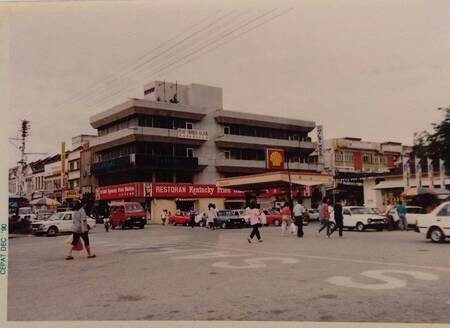

“Foto tahun 1985. Petrol stesyen Shell di pekan Kajang sebelah stesyen bas Fuh Hup .foto olih Mustafa Yahya.” (Tapa Seni Rimba @ Facebook Bandar Kajang Group, 10 Disember 2017: |"Foto tahun 1985. Petrol stesyen Shell"). “Saya sampaikan stesyen petrol SHELL sebelah KFC Kajang juga bersebelahan bazaar ABC yang popular itu.” (Tapa Seni Rimba @ Facebook Bandar Kajang Group, 5 November 2018: "stesyen petrol SHELL"). 17 Oktober 2019: |"Maseh anda ingat lokasi ini dipekan Kajang sekitar tahun 1980an?").

“Shell Bandar Kajang kini tinggal kenangan (1952 - 2016)” (Facebook Bandar Kajang, 15 Mei 2017: "Shell Bandar Kajang kini tinggal kenangan (1952 - 2016)").
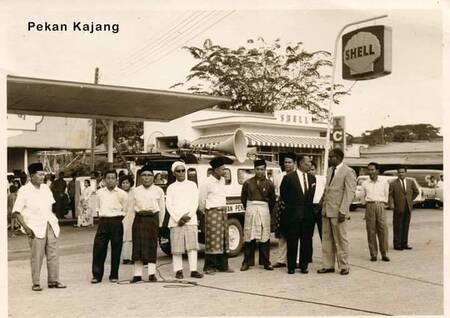

“Now the Shell is no more” - Shanker Nanthini. “Berdiri 3 dari kiri… Arwah Hj tasmin bin sakiban, pengasas satay kajang … Moyang” - Idah Sha (Facebook Bandar Kajang, 28 Oktober 2019: |"KAJANG": Shell Kajang, 1952. Gambar warna (”colorized“) oleh Mohamad Fareez).
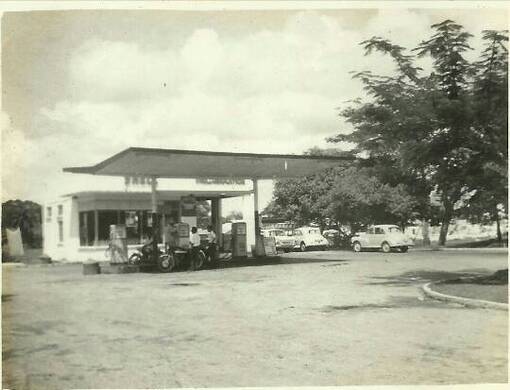

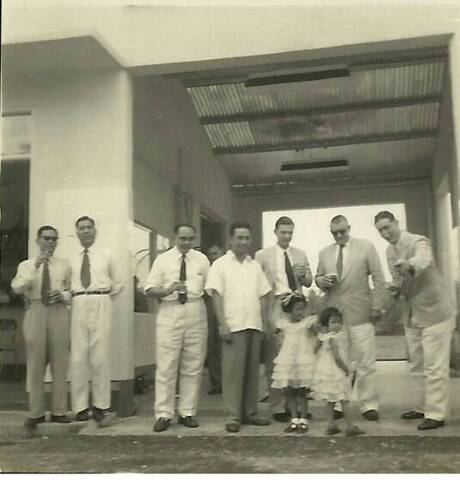

“Surat penghargaan buat semua bekas pelanggan Shell Bandar Kajang: Dear Customers / Friends , The Sin Kee Sang Shell petrol station (situated along Jalan Semenyih, Kajang, beside Prescott Hotel) was started by the late Mr Kong Siew Kuin in 1952. Our last day of retail trading was on the 30 November 2016. We would like to take this opportunity to thank all of you for your loyal support over the 64 years of service. We would like to share with you some old photos taken during the initial opening ceremony in 1952. The only landmark then was the old Lutheran Church (timber building) located opposite the Shell station. This church building has since been relocated beside Yu Hua School several years ago. We have plans to redevelop the land. Thank you for your patronage over the years.
From : The Management & Staffs of Sin Kee Sang Shell Station, Jalan Semenyih, Kajang.” (Facebook Bandar Kajang, 11 Januari 2017: "Surat penghargaan buat semua bekas pelanggan Shell Bandar Kajang").
Chip Lee / Czip Lee
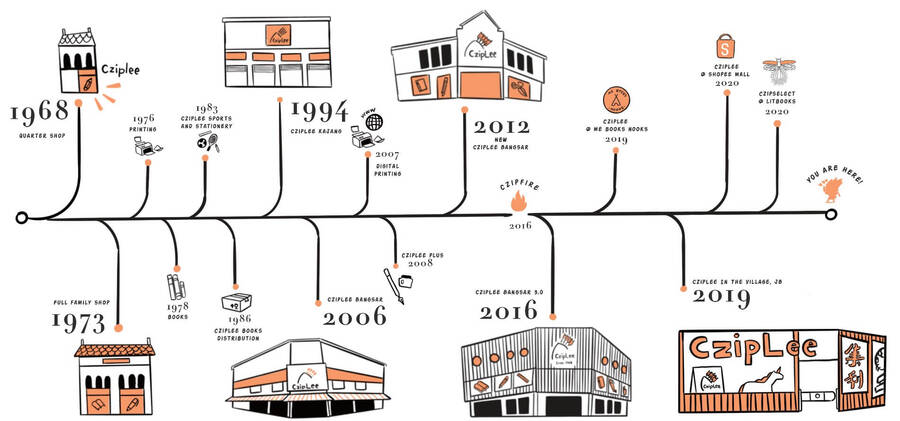
Kedai buku dan alatulis “Chip Lee” (atau ejaannya kini: “Czip Lee”, diasaskan di Kajang pada tahun 1968): “From a store in Kajang, we have now grown to operate 2 more branches in Bangsar and Southkey, Johor- each unique in their own way. While the store in Kajang mainly focuses on school and office supplies, our Johor outlet acts as the port where only the best of the best products are assembled and offered.” (CzipLee Group Of Companies, 2021: |"A little history about us").
Oren Tin Jooi Wah
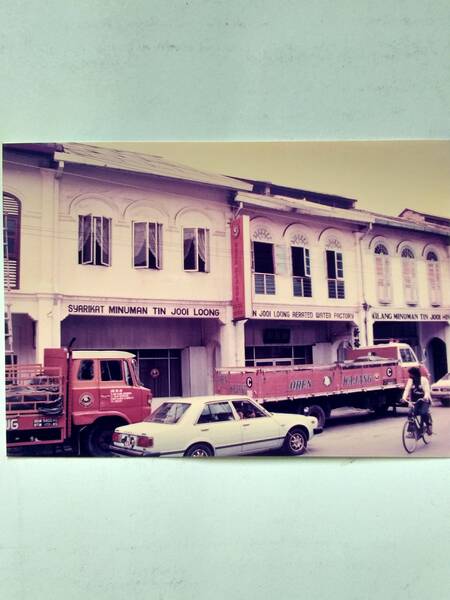

Kiri: “Kedai Oren Kajang di Jalan Medaling telah dijual. Keluarga Long ( keturunan Hailam) dgn Nama kedai Tin Jooi Loong. Ada lagi Ais Krim Soda yg belum buka di Kajang Heritage Centre. - Kim Sin Lee” (Tapa Sen Rimba @ Facebook Bandar Kajang Group, 28 November 2017: |"Anda masih ingat kilang oren di Kajang?").
Kanan: “David Long, tauke Tin Jooi Wah (Oren Kajang), 80 tahun. 'Ayah saya datang ke Malaya dari Hainan, China semasanya berumur 13 tahun. Dia bekerja di kilang minuman air bergas di Kuala Kubu Baru. Selepas beberapa tahun kemudian, dia berputus untuk membuka satu kilang air bergas di Kajang, iaitu Tin Jooi Wah (Oren Kajang). Kilang ini tutup operasinya pada tahun 2009.'” (Kajang Heritage Centre乌鲁冷岳社区文物馆, 14 Februari 2015: "David Long, tauke Tin Jooi Wah (Oren Kajang), 80 tahun").
Ali Store
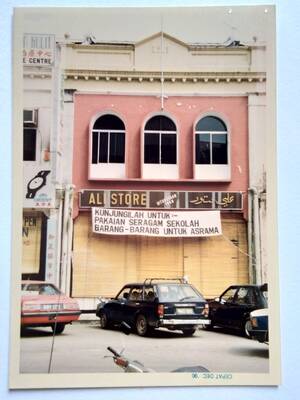
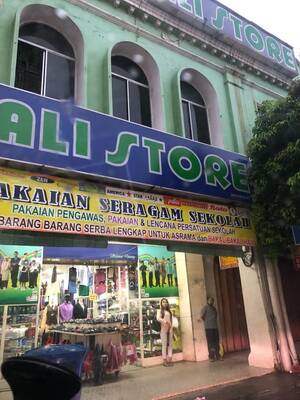
Kiri: Ali Store, 1990 (Tapa Seni Rimba @ Facebook Bandar Kajang Group, 18 Mei 2019: "Ali Store Kajang masih ada .").
Kanan: Ali Store, kini (Facebook Bandar Kajang, 3 Disember 2019: "Ali Store dan Mubarak Store").
Restoran Al-Ehsan
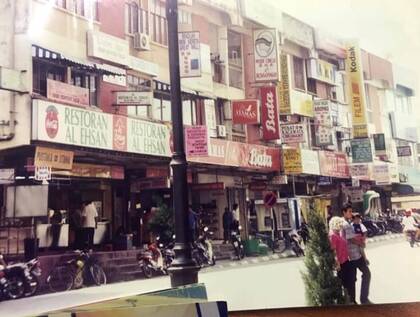

“Kenangan Bandar Kajang. Apa menu kegemaran anda di restoran ini? Foto kiriman Shafiq Ahmad” (Facebook Bandar Kajang, 21-22 Julai 2020: |"Kenangan Bandar Kajang (1)"; |"Kenangan Bandar Kajang (2)").
Arked MARA


Arked MARA dalam pembinaan, 1981 (Tapa Seni Rimba @ Facebook Bandar Kajang, 30 September 2017: "Tahukah anda bangunan apakah ini?").
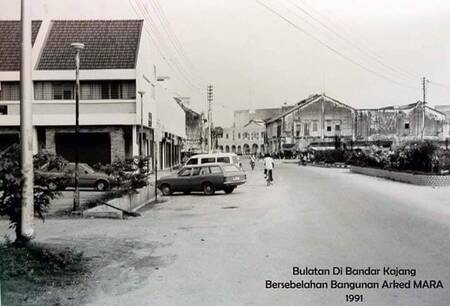

“The Mara aked used to be the wet market” - Augustus Walter CN Jacobs. “Kalau skrg ni berdiri atas jalan keretapi bawah jejantas @ jalan antara plaza metro & arked mara.” - Ns Riza. “The overhead at the Mara Aked killed its business” - Nantha Kumar Appadurai. “Kedai rojak dan endol ….jadi tumpuan …rojak 30 sen …cendol 15 sen” - Kak Miera. (Facebook Bandar Kajang, 28 Oktober 2019: |"KAJANG": Bulatan di Bandar Kajang Bersebelahan Bangunan Arked MARA, 1991. Gambar warna (”colorized“) oleh Mohamad Fareez).
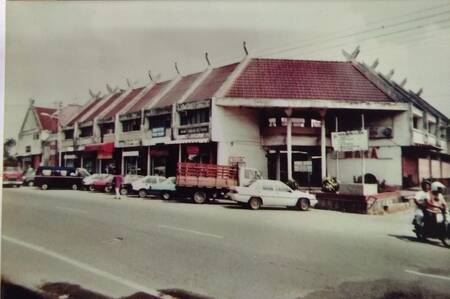

“Bangunan Aked Mara Kajang. Saya menyelia binaan bangunan ini pada tahun 1981. Tapak bangunan Aked Mara ini asalnya pasar Kajang.” Kiri: 1990-an. Kanan: Kini (2010). (Tapa Seni Rimba @ Facebook Bandar Kajang Group, 1 November 2018: "Bangunan Aked Mara Kajang").
Billion

“Saya jumpa foto shopping kompleks Billion Kajang, shopping kompleks ini popular pada warga Kajang masa dulu.
Mustafa Yahya pelukis hulu langat.” (Tapa Seni Rimba @ Facebook Bandar Kajang, 29 Jun 2017: |"shopping kompleks Billion Kajang").
Tempat Ibadat
Masjid Jamek


“Masjid ini adalah dibina pada tahun 60an apabila ujudnya bandar Kajang dan keperluan ibadah bagi masyarakat Kajang. Masjid ini telah dirasmikan oleh DYMM Sultan Sallehuddin Abd Aziz Shah Alhaj pada tanggal 14 May 1971.” (Jabatan Kemajuan Islam Malaysia: |"MASJID JAMEK PEKAN KAJANG". Gambar kiri: Mohd Nasir Abdul Rashid, April 16, 2008: |"Kajang Town").
Tokong Shen Sze She Yar



Kiri: “The front of the Shen Sze See Yar temple faces the riverbank.” (Lee Khang Yi @ Malay Mail, 24 Apr 2016: |"The muhibbah factor: Reunited for the love of cendol and rojak in Kajang").
Tengah: “Grand entrance of Shen Sze She Yar temple. Established in 1898, the Kajang Shen Sze She Yar Temple relocated from Rekoh in 1892. Incense was brought from Cheng Koon Temple in Rasa. The temple was renovated and extended over the years but the main structure was retained. Inside, you will find well-kept artifacts and records in the gallery set up by the Temple Management Committee in 2015. Exhibits include a 120-year-old gong made of cast iron and a more than 100-year-old wood bat door knob which symbolises luxury. According to Cikgu Lee, in 1860, war broke out in Sungai Ujong due to conflict over ownership of tin mines. Kapitan Seng Meng Lee, a respected community leader in Lukut, was beheaded when his men lost. Legend has it that the blood which gushed out was white so he was deified as an immortal and honoured by the followers as Lord She Sze She Yar at Cheng Koon Temple in Rasa in 1861.” (Hanna Hussein @ The New Straits Times, December 19, 2019: |"#JOM! GO: More than satay").
Kanan: “History buffs can trace the origins of this temple to Kapitan Yap Ah Loy and the popular Sin Sze Si Ya temple in KL.”
(Sumber video: TV2《前线视窗》 , 5 Mei 2016: "老加影之古庙与古教堂").
MAKLUMAT LANJUT: Tokong Shen Sze She Yar
Cendol Tokong
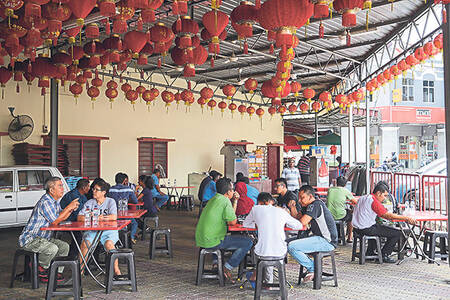

Kiri: “Diners sit under a canopy of red latterns to enjoy their fried noodles and cool treats. — Pictures by Choo Choy May”
Kanan: “You can also sit in front of the stall to watch the shaved ice action.”
(Lee Khang Yi @ Malay Mail, 24 Apr 2016: |"The muhibbah factor: Reunited for the love of cendol and rojak in Kajang").
“Those who grew up in the old town of Kajang will know of a food stall operating outside the Shen Sze She Yar Temple gates. … Famous for its cendol, ais kacang (ABC), rojak mee and mee goreng, the stall maintains a casual no-frills atmosphere where customers can place their orders at the counter or wait for a server to take their orders. With big red lanterns as decorations, the 121-year-old temple canopy gives some reprieve to customers while dining under the scorching heat. When asked about the history of Cendol Tokong, Syed Abu Thahir, 38, explained that the business was started by his late grandfather in the 1980s. “He pedalled around the Kajang area selling cendol at that time. “He then took up a temporary spot a few metres away from the temple before the temple committee offered him a space to rent in 1996. That was how our business here started,” said Syed. After setting up shop, his grandfather then added five new dishes — rojak mee, fried mee hoon, boiled noodles, fried noodles and ABC — to the stall’s offerings. After his passing, the reigns of the business were passed on to his son and subsequently changed hands when Syed (the grandson) took over. Syed presently manages the stall with other relatives. … Cendol Tokong at Jalan Mendaling is a five-minute walk from the Stadium Kajang MRT station.” (Shalenny Carino @ The Star, 27 Aug 2020: |"Nothing beats Kajang’s Cendol Tokong").
Kuil Sri Subramaniya Swami


“The Temple is the oldest established Hindu Temple in Kajang which has witnessed the development of Kajang Town from a rural settlement to a modern suburban township.” (Lee Kim Sin, 16 Januari 2016: "Sri Subramaniya Swamy Temple Kajang is celebrating its Centennial Anniversary this year (1916-2016)").
Kawasan Sekitar
Koleksi Gambar
Berikut adalah koleksi gambar-gambar Kajang sekitar tahun 1980-an dan 1990-an yang ada ditemui di ruang Internet.
Koleksi Majlis Perbandaran Kajang (MPKj)


Kiri: “Kaunter-kaunter lama plaza tol Kajang” (1987); Kanan: “Ibu Pejabat Polis Daerah Kajang adalah sebuah kompleks 3-dalam-1. Balai Polis Kajang dan Cawangan Trafik IPD Kajang turut diletakkan di dalam kawasan IPD ini.”
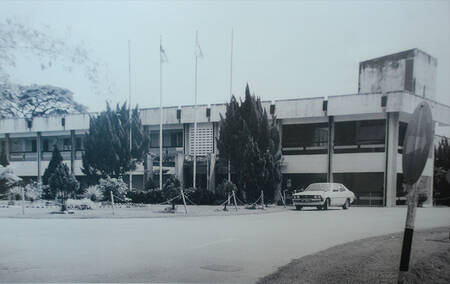

Kiri: “Pemandangan hadapan Pejabat Daerah Hulu Langat - Majlis Daerah Hulu Langat” (1987); Kanan: “Jalan Sulaiman di pekan Kajang sebelum mengalami perubahan.” (1981).


Kiri: “Pada 29 April 1967, Sultan Selangor telah merasmikan stesen pemancar Seberang Laut RTM yang baru di Kajang, Selangor. Ini ialah Pejabat Radio TV Malaysia Kajang yang terletak di Jalan Kelab Selangor.” (1987); Kanan: “Pejabat Pos Kajang yang terletak di Jalan Hishammudin.” (1985).


Kiri: “Bangunan Perpustakaan Cawangan Ulu Langat, Perbadanan Perpustakaan Awam Selangor pada 1984. Bangunan ini kini menempatkan francais sate Hj Samuri yang terkenal.” (1984); Kanan: “Pemandangan hadapan Hospital Daerah Kajang yang terletak di Jalan Semenyih pada 1984. Hospital ini ditubuhkan pada tahun 1889 sewaktu penubuhan Kajang.” (1984).

“Bangunan lama Lembaga Letrik Negara (LLN) Kajang pada tahun 1983. Bangunan ini terletak berhampiran Bulatan Kajang.” (1983).
Sumber gambar-gambar: Majlis Perbandaran Kajang (MPKj), 1981,1983,1984,1985,1987 @ Astro Awani, Februari 14, 2014: |"Pekan Kajang: Dulu & Sekarang".
Koleksi Restoran JR Ehsan




“Kalau anda masuk ke Restoran JR Ehsan lokasi betul-betul berhadapan pintu masuk utama Plaza Metro Kajang, anda boleh tengok koleksi gambar bangunan-bangunan ikonik Bandar Kajang suatu masa dahulu.. Memang menggamit memori sungguh.. Geng-geng lepak Kajang 80-90an sila hadir” (Facebook Pekan Bangi, 25 Mei 2025: "Restoran JR Ehsan").
Koleksi Mustafa Yahya (Tapa Seni Rimba)
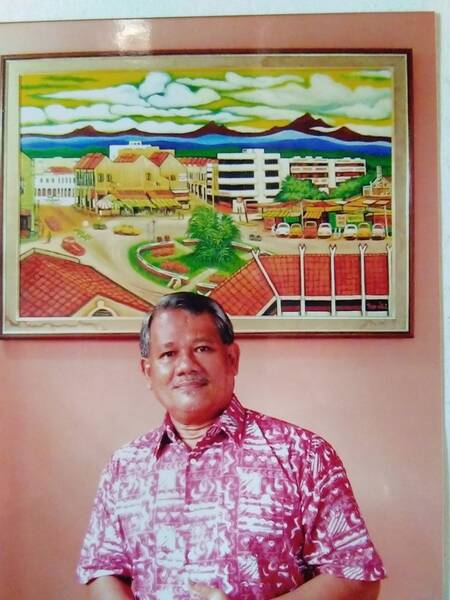

Mustafa bin Yahya (Tapa Seni Rimba): “Satu lagi versi lukisan pekan Kajang tahun 1982, saya lukis dalam konsep cubism. Saya masih simpan lukisan ini yang berusia 36 tahun,
Cat minyak / kanvas ukuran 30” x 40”.“ (Tapa Seni Rimba @ Facebook Bandar Kajang Group, 3 November 2018: "Satu lagi versi lukisan pekan Kajang tahun 1982").

“Lukisan saya pekan Kajang tahun 1982. Lukisan cat minyak atas kanvas. Saya masih simpan lukisan ini.” (Tapa Seni Rimba @ Facebook Bandar Kajang Group, 31 Oktober 2018: "Lukisan saya pekan Kajang tahun 1982"). 18 Oktober 2019: |"Lukisan saya pada tahun 1982 lokasi pekan Kajang").

“Satu masa dulu , lokasi sebelah metro plaza Kajang.” (Tapa Seni Rimba @ Facebook Bandar Kajang Group, 7 Mac 2019: "Satu masa dulu , lokasi sebelah metro plaza Kajang.").
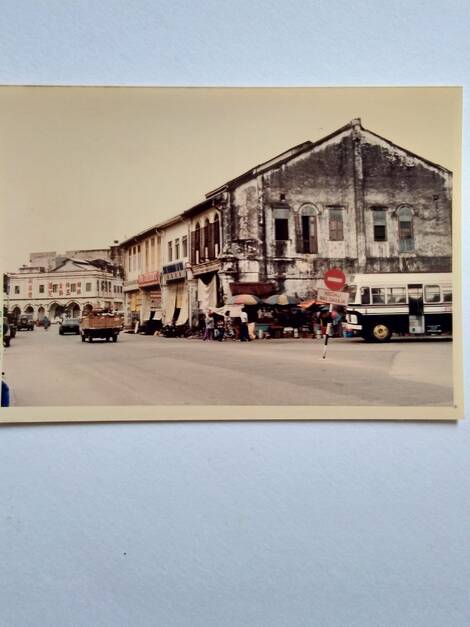

(Tapa Seni Rimba @ Facebook Bandar Kajang Group, 17 Februari 2018: "Selamat pagi Kajang").
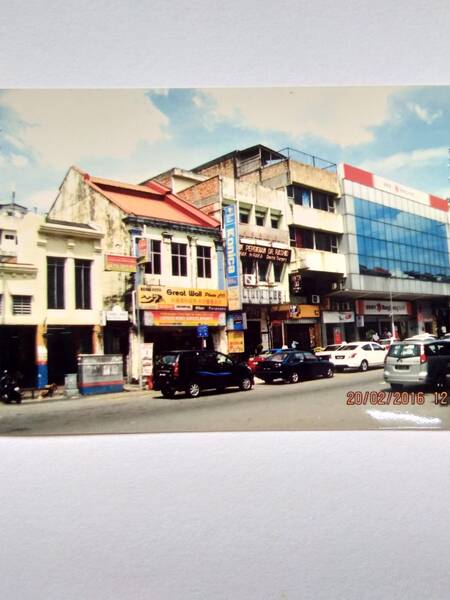

Kiri: “kawasan ini di Kajang ,dulu famous dengan mee hailam .” (Tapa Seni Rimba @ Facebook Bandar Kajang Group, 29 April 2019: "famous dengan mee hailam").
Kanan: “Kesesakan jalan dibandar Kajang ,keadaan berlaku sejak dari tahun1990an” (Tapa Seni Rimba @ Facebook Bandar Kajang Group, 24 Jun 2017: "Kesesakan jalan dibandar Kajang").
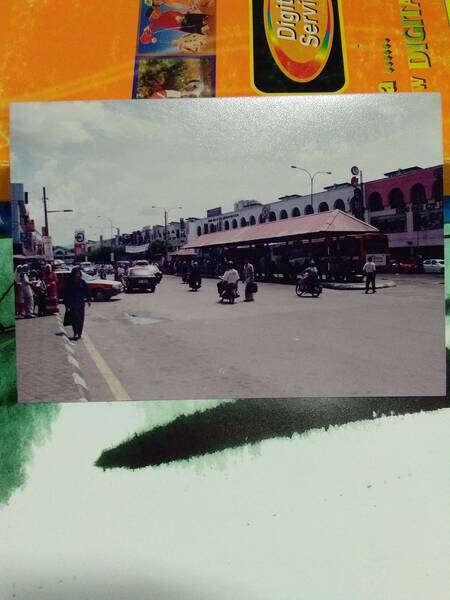

Kiri: “Hentian bas lama” (Tapa Seni Rimba @ Facebook Bandar Kajang Group, 22 Jun 2017: |"lokasi ini dibandar Kajang").
Kanan: “Depan metro kajang laluan ke kfc kajang - Sapuan Wan” (Tapa Seni Rimba @ Facebook Bandar Kajang Group, 4 Julai 2017: |"Lokasi di bandar Kajang.").
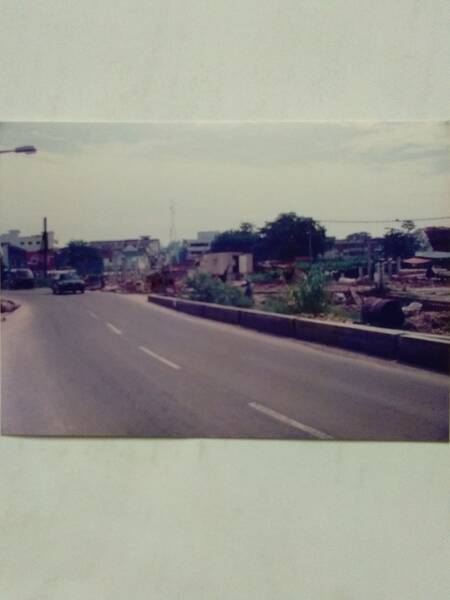

Kiri: “Ini jalan reko lama dari pekan Kajang ke Ukm, lokasi berhampiran pintu pagar keretapi,semasa saya ambil foto ni pagar itu telah tiada kerana kerja2pengubahsuaian jalan telah bermula. Mustafa Yahya pelukis hulu langat.” (Tapa Seni Rimba @ Facebook Bandar Kajang Group, 30 Julai 2017: |"Ini jalan reko lama dari pekan Kajang ke Ukm").
Kanan: “Gudang beras jalan Reko Kajang.” (Tapa Seni Rimba @ Facebook Bandar Kajang Group, 22 Januari 2018: "Gudang beras jalan Reko Kajang").
Gambar-Gambar Kedai

Sebahagian koleksi gambar-gambar kedai di laman ini: |"Kajang Town Houses".
Cabaran Pemeliharaan Sejarah dan Sosio-Budaya Kajang


“The various culture of Kajang & people unfolding through layers of diversity … Sense of belongings with enrichment of old culture, the business that runs on the day & everyday, to make sure the life is on-going … The lack of quality for old generation to be able to adjust to new condition, similarly for the new generation as they hardly adapt to the old culture of Kajang. The old and new are co-exist within the same Kajang yet disconnected in terms of fusion of culture and communication. … The remnants of unmaintained structures, abandoned closed shophouses and the recession of old businesses from time to time tends to increase the possibility of displacement issue as the increase of new development and immigrants causing fading of sense of belonging. … Kajang is dynamic in its aspect of walkability, accessibility with diversed people using the public spaces, yet it is not dynamic in the aspect of cultural integration.” (Yeo Shi Jie, Jul 30, 2020: |"[ A DYNAMIC KAJANG: SITE B ] - Project 1 - 'Preliminary Study’ - Urban Analysis & Precedent Studies").
Pengakuan penting: Kami bukan ahli sejarah! Sila klik di sini untuk penjelasan lanjut.
